When I was in Egypt in 2001, I took a note of the fact that I hadn’t visited one exceptionally important and significant place, so in 2008, I decided to correct that. I did it in October by going to Sharm El-Sheikh for a “summer vacation” – it was still warm enough there to swim in the sea and relax in the sun. Admittedly, towards the end of my 10-day stay, the trade winds started to blow, so there was a wind-chill factor, but that trip absolutely served its purpose. I rested, which was important because I had caught a cold before the trip, plus I saw what I wanted.
Here is a map showing where I went during this trip:
This trip has remained particularly memorable for me because I took with me my mother, who was 75 years old at the time. Although she knew where we were going, I didn’t tell her about all the details, so staying at a top-notch all-inclusive resort was a big surprise for her and she was delighted like a child.
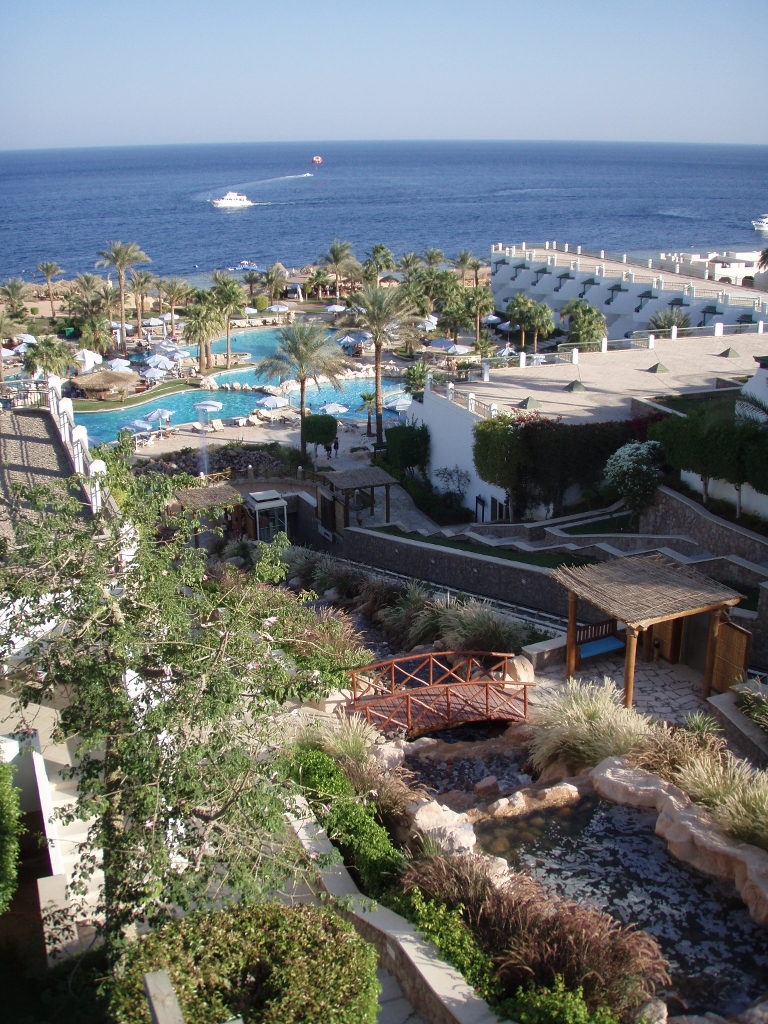 Resort in Sharm El-Sheikh
Resort in Sharm El-Sheikh
I was glad that I could afford to do something like that and bring her joy. My parents, despite occasional “mistakes” we all make, which seem larger when they come from parents than from anyone else, were wonderful parents, completely devoted to their children and family. Being fully aware of this and as someone who believes to have overcome “childhood traumas,” I enjoyed doing various things for them, mostly small gestures – actually, their greatest joy was seeing me as often as possible, so I made an effort to visit them almost every day. As for the trip to Egypt, I would have taken my dad too, but he wasn’t interested.
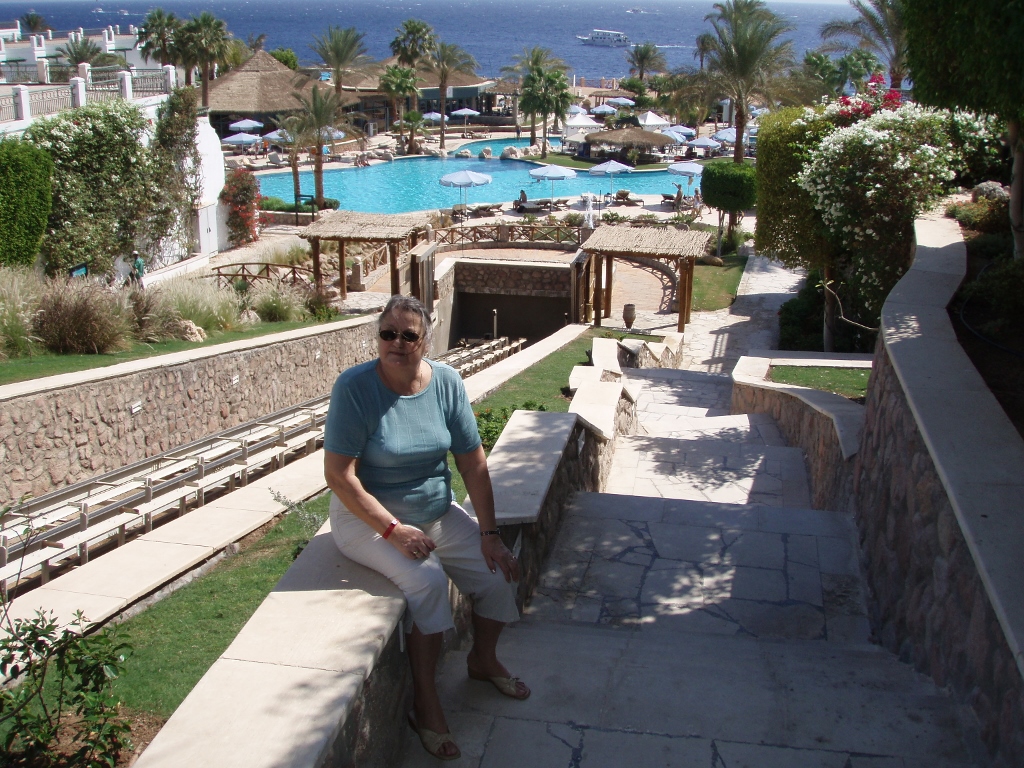 My mom at the resort in Sharm El-Sheikh
My mom at the resort in Sharm El-Sheikh
So, during the first few days, we mostly lay by the pool, socialising with a family from Serbia.
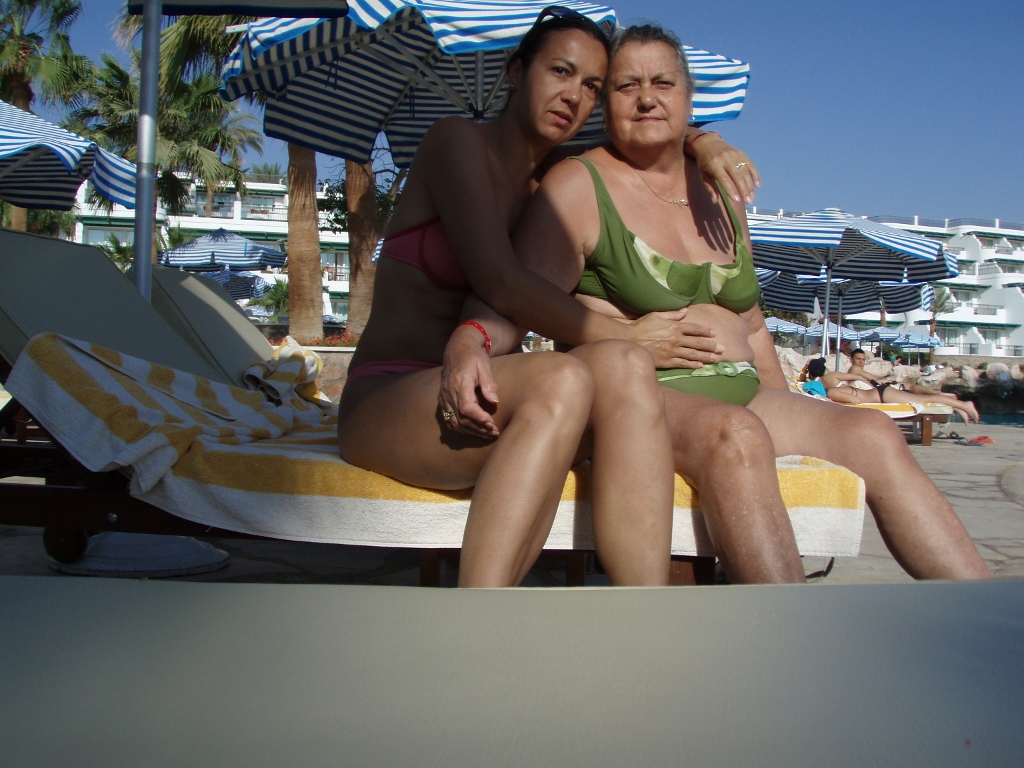 With my mom during the vacation in Sharm El-Sheikh
With my mom during the vacation in Sharm El-Sheikh
I actually don’t particularly enjoy pools when I’m on vacation, but in Sharm El-Sheikh, there aren’t many natural beaches. Among other things, the reason for my attitude towards pools was more than clear here – the resort added some chemicals to the water in the pool every morning to kill whatever needed to be killed and since I have a habit of looking in the water while swimming, my eyes stung terribly. When I swam in the sea, there was none of that.
Formally speaking, the resort I chose actually had a smaller sandy beach between the rocks that characterise this coastline.
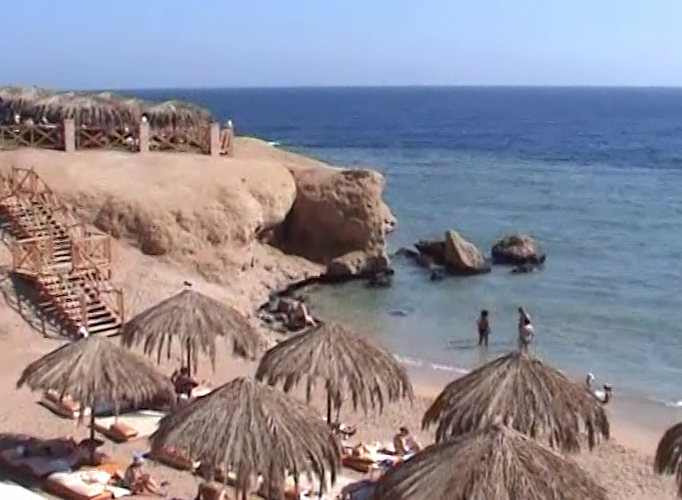 Coast by the resort in Sharm El-Sheikh
Coast by the resort in Sharm El-Sheikh
But from the shoreline and the beach, there was a stretch of coral reefs covered with shallow water and it’s definitely not advisable to enter there. On the one hand, I believe it’s prohibited in order to prevent damage to the corals and, on the other, they could seriously injure one’s feet as they are often sharp. Several tens of meters further, there’s a sudden drop of the seabed (which can be seen by the colour of the sea) and right at that point of transition from the shallow to the deeper water, the resort had installed a pontoon connected to the beach with a floating bridge.
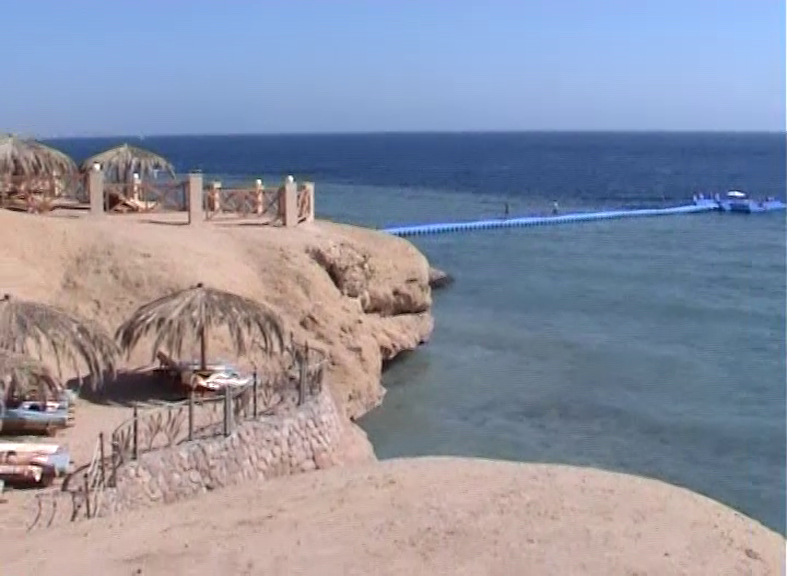 Coast by the resort in Sharm El-Sheikh
Coast by the resort in Sharm El-Sheikh
Since the “bridge” wasn’t fixed, it moved up and down in the rhythm of the waves passing underneath. There are “rails” made of ropes on the bridge and occasionally it was necessary for one to hold onto them or have an excellent sense of balance. In any case, I made sure to cross the bridge as quickly as possible.
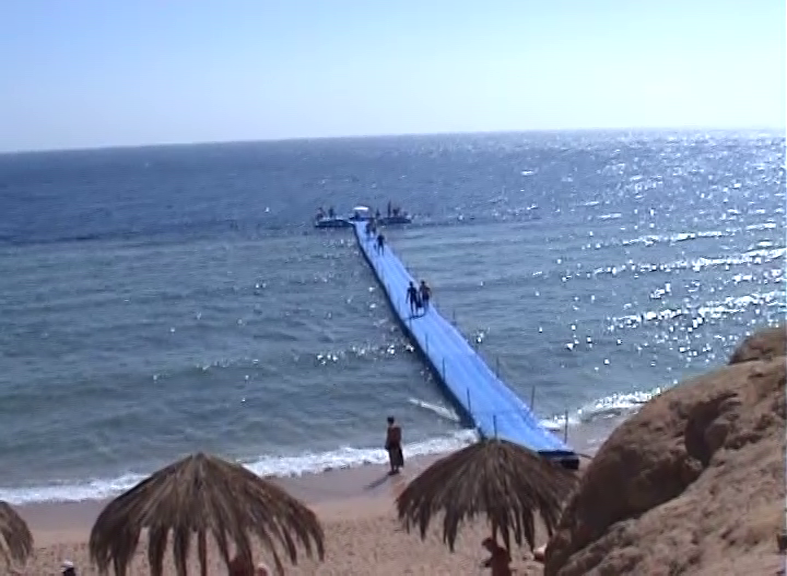 Pontoon bridge by the resort in Sharm El-Sheikh
Pontoon bridge by the resort in Sharm El-Sheikh
On the pontoon, there were also stairs for exiting the sea, so I went there every day to swim and to observe the underwater world, as it was an ideal spot.
Over time, I clearly noticed that certain fish, like people, have their “homes” or parts of the coral reef where they can regularly be seen.
I don’t know much about fish; I might know the scientific name of a species here and there, but that wasn’t important to me at all and I enjoyed the beauty regardless.
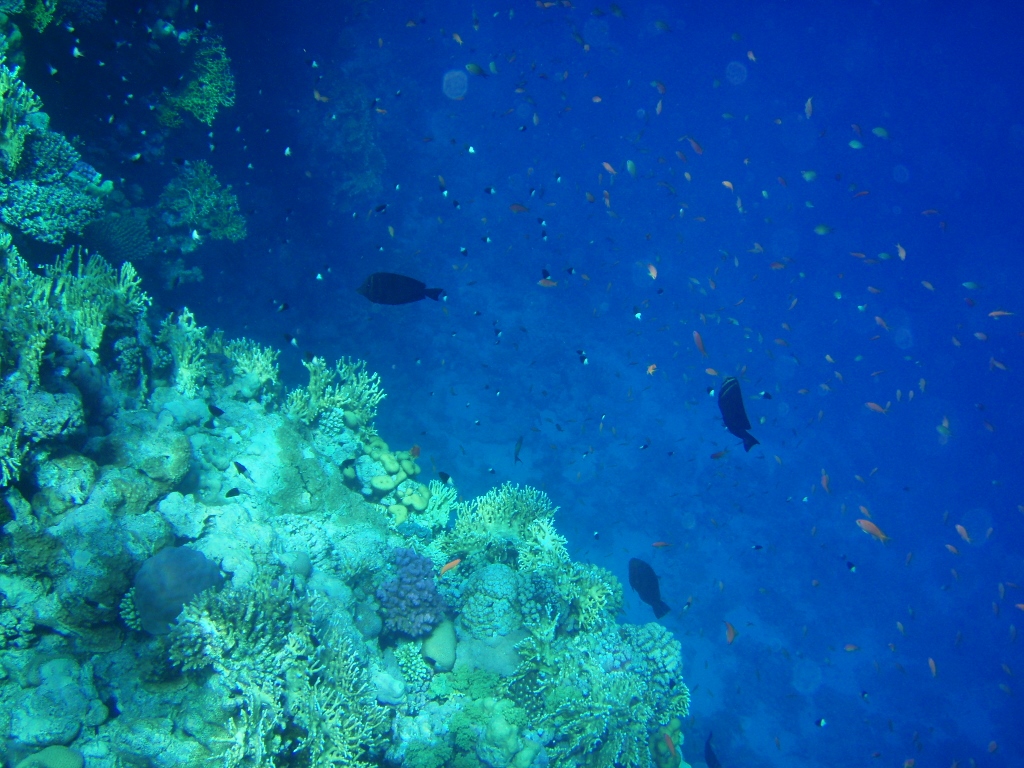 Drop of the coral reef towards the depth
Drop of the coral reef towards the depth
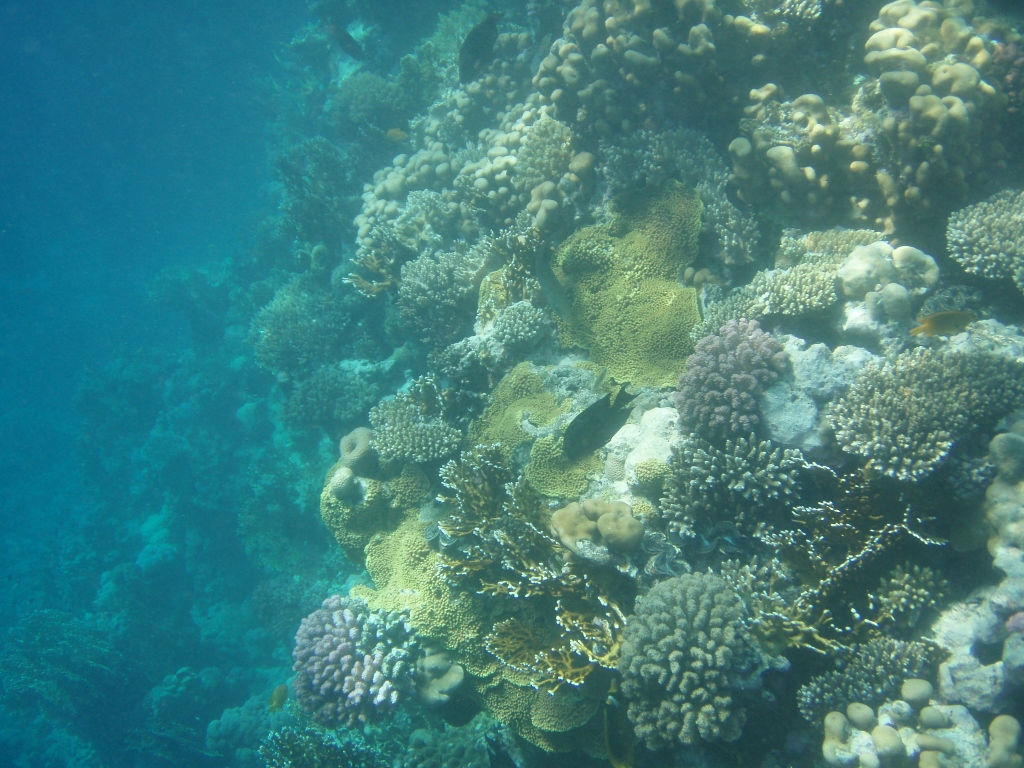 Drop of the coral reef towards the depth
Drop of the coral reef towards the depth
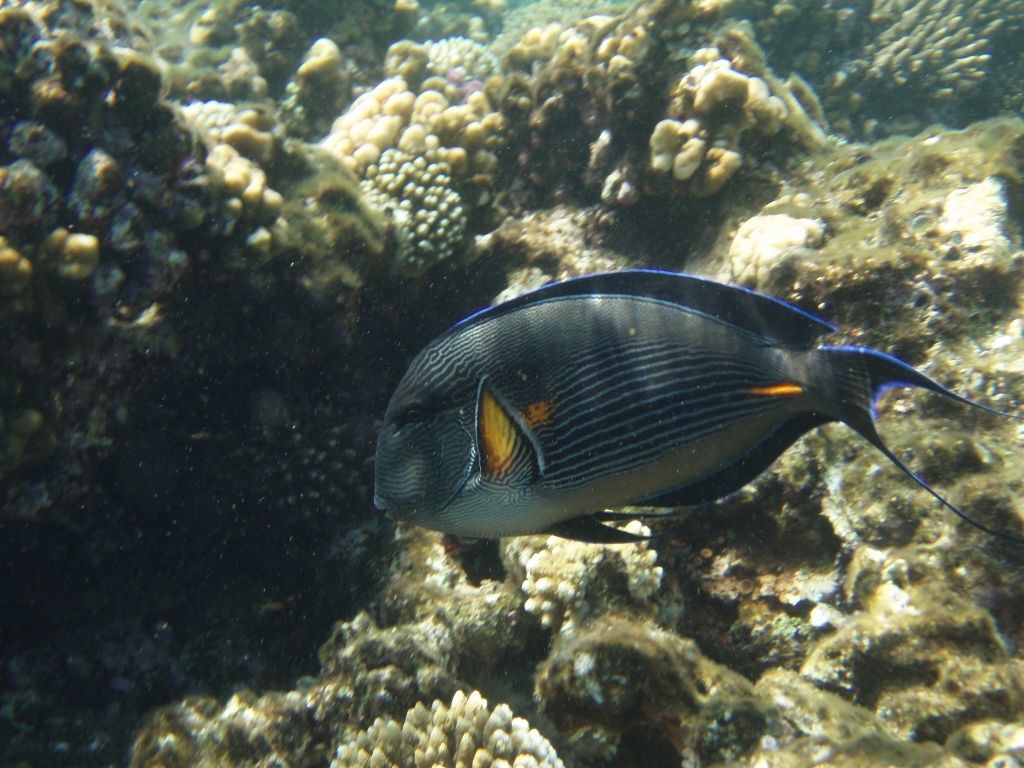 Red Sea marine life
Red Sea marine life
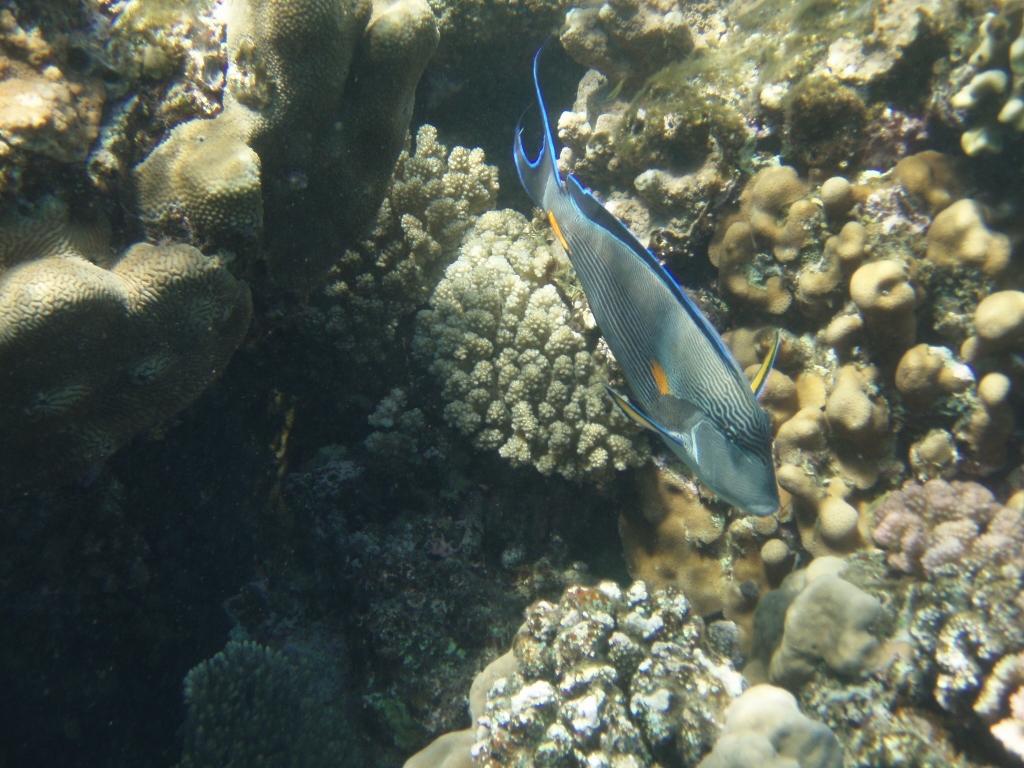 Red Sea marine life
Red Sea marine life
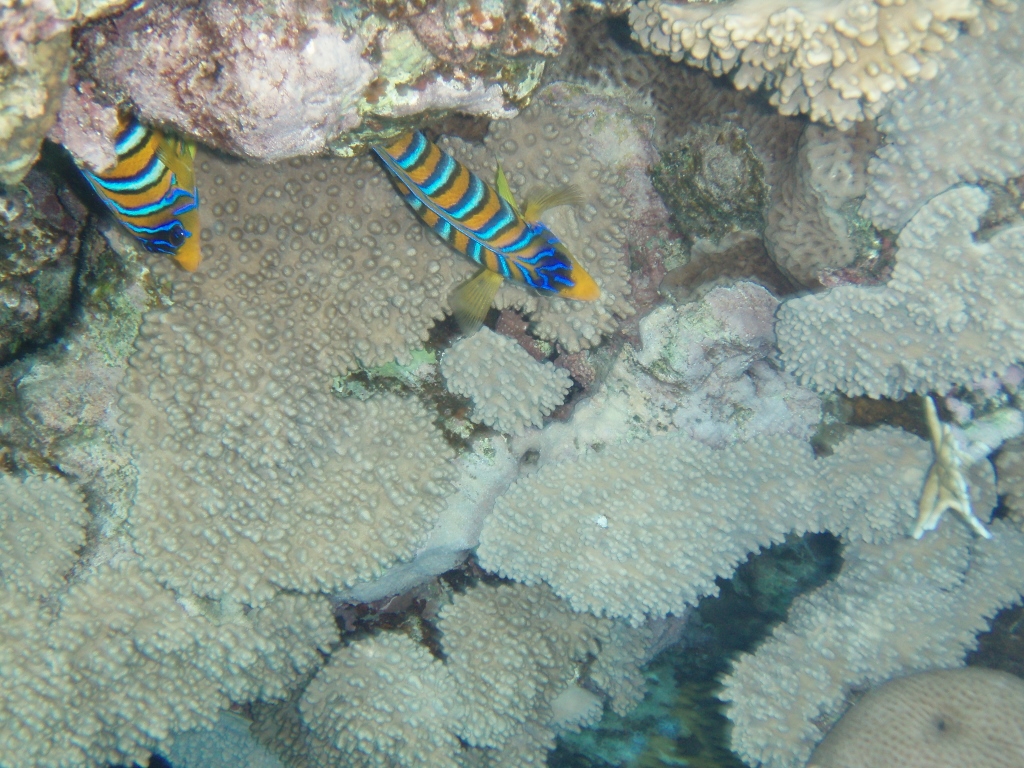 Red Sea marine life
Red Sea marine life
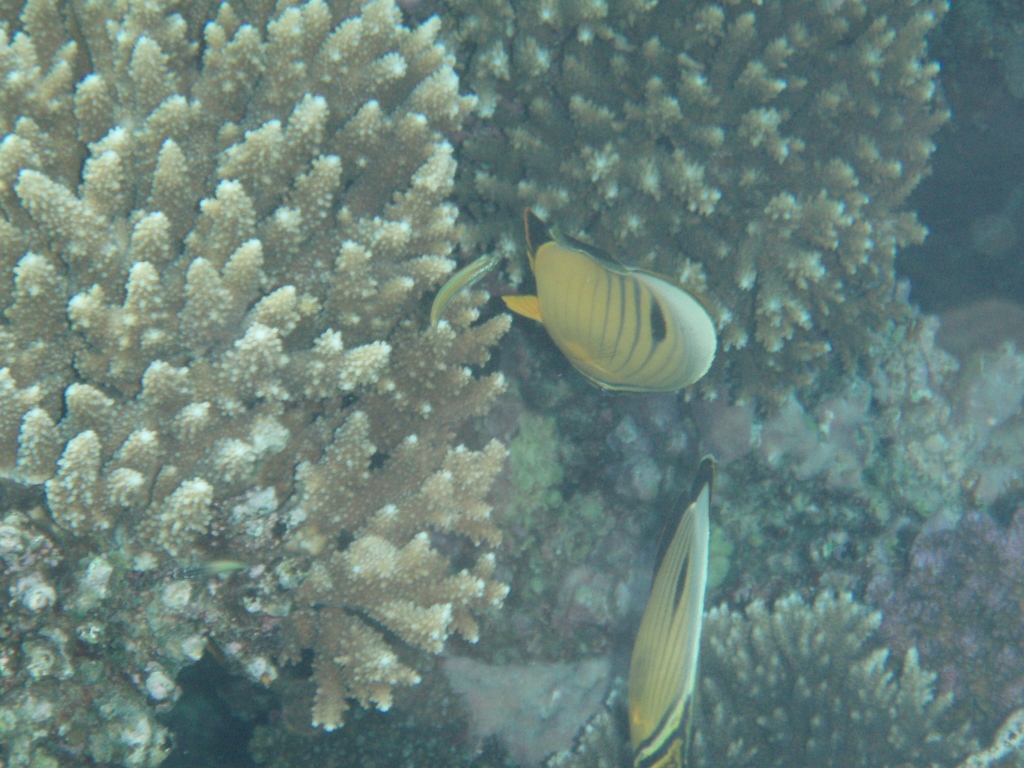 Red Sea marine life
Red Sea marine life
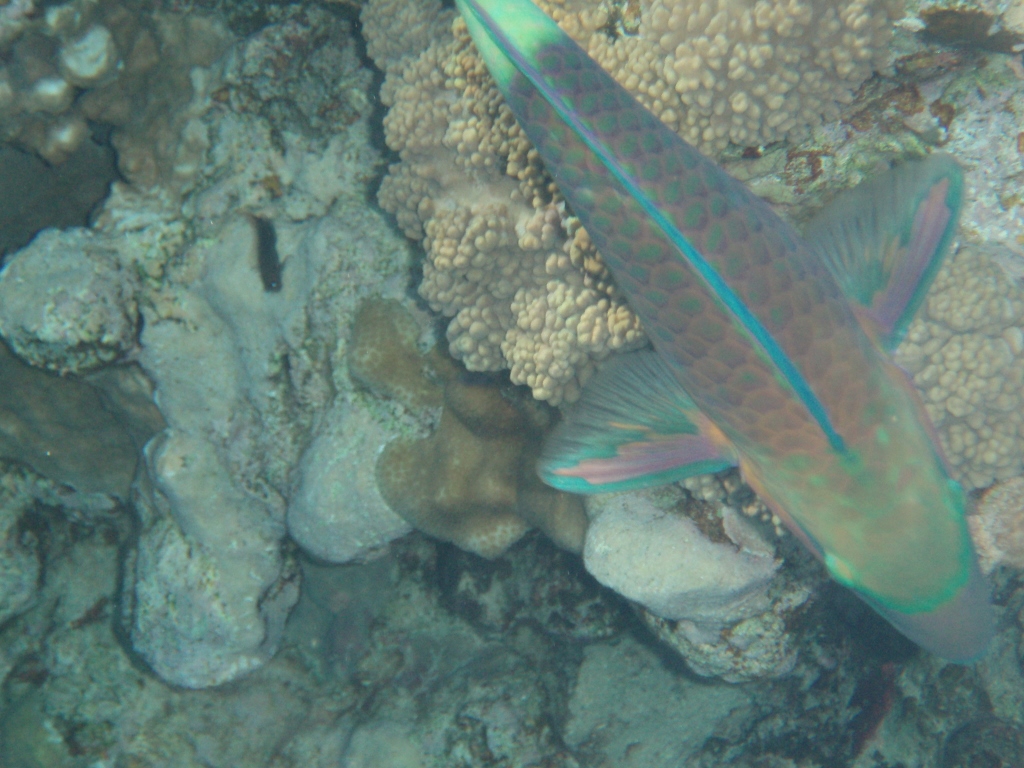 Red Sea marine life
Red Sea marine life
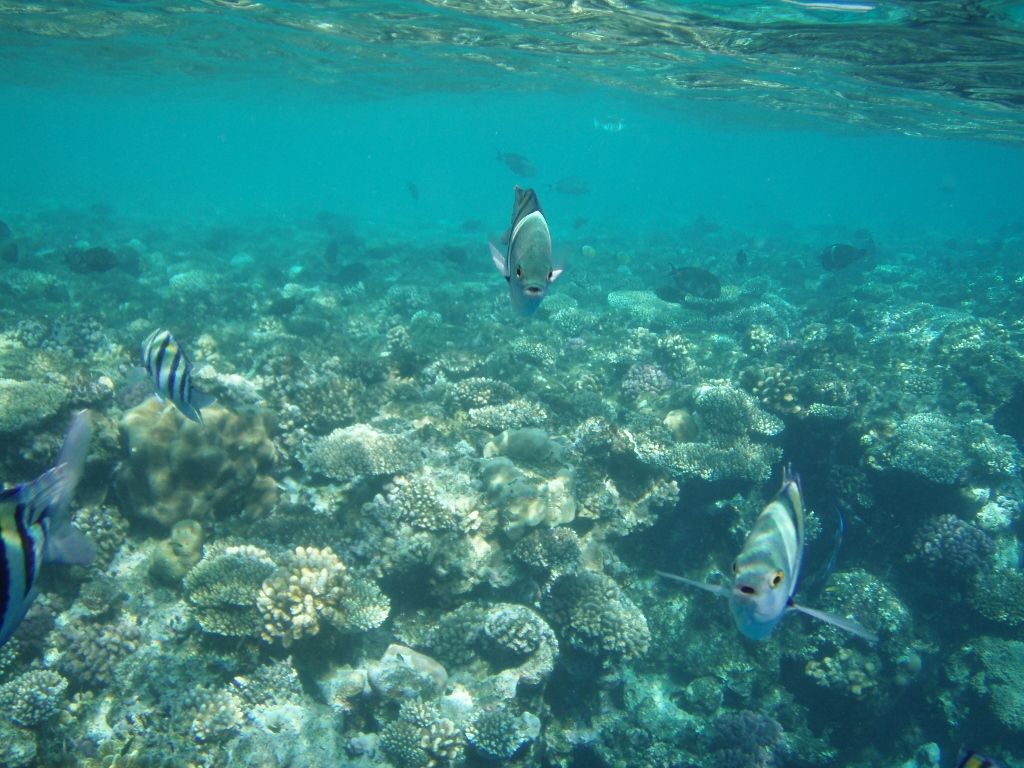 Red Sea marine life
Red Sea marine life
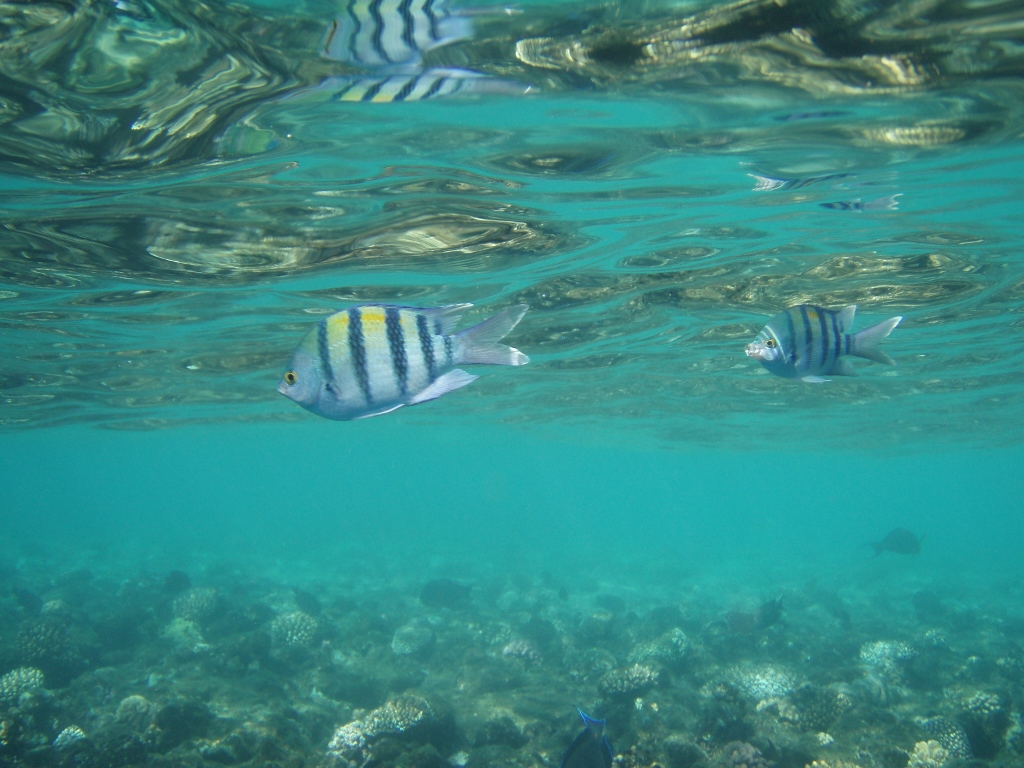 Red Sea marine life
Red Sea marine life
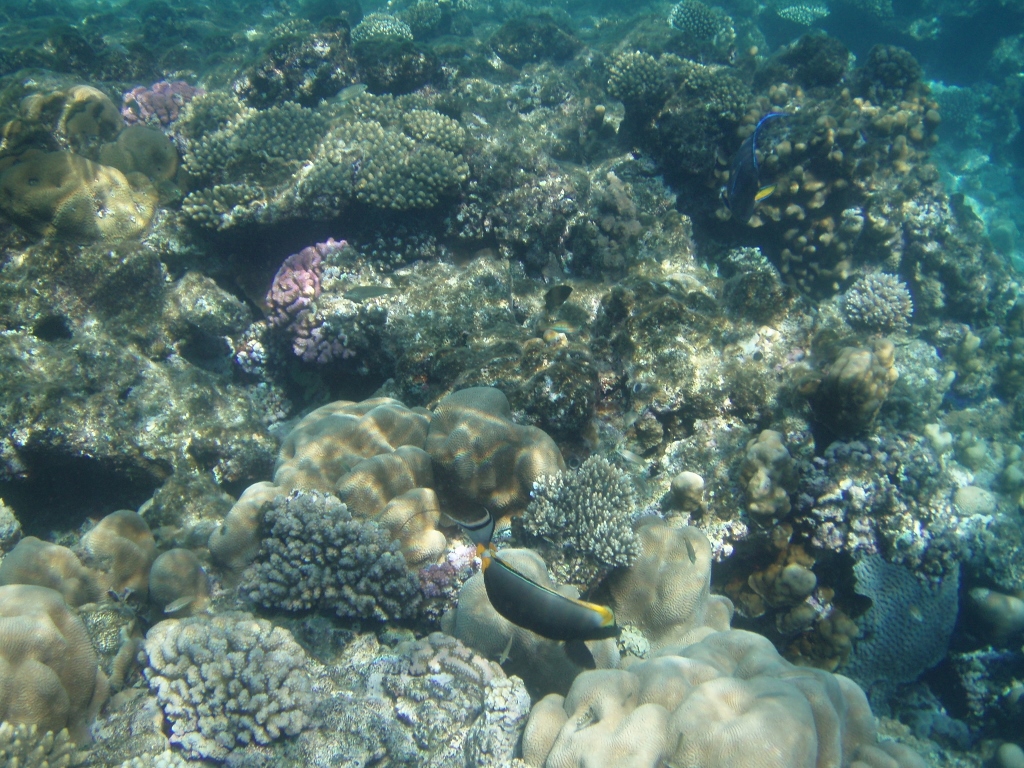 Red Sea marine life
Red Sea marine life
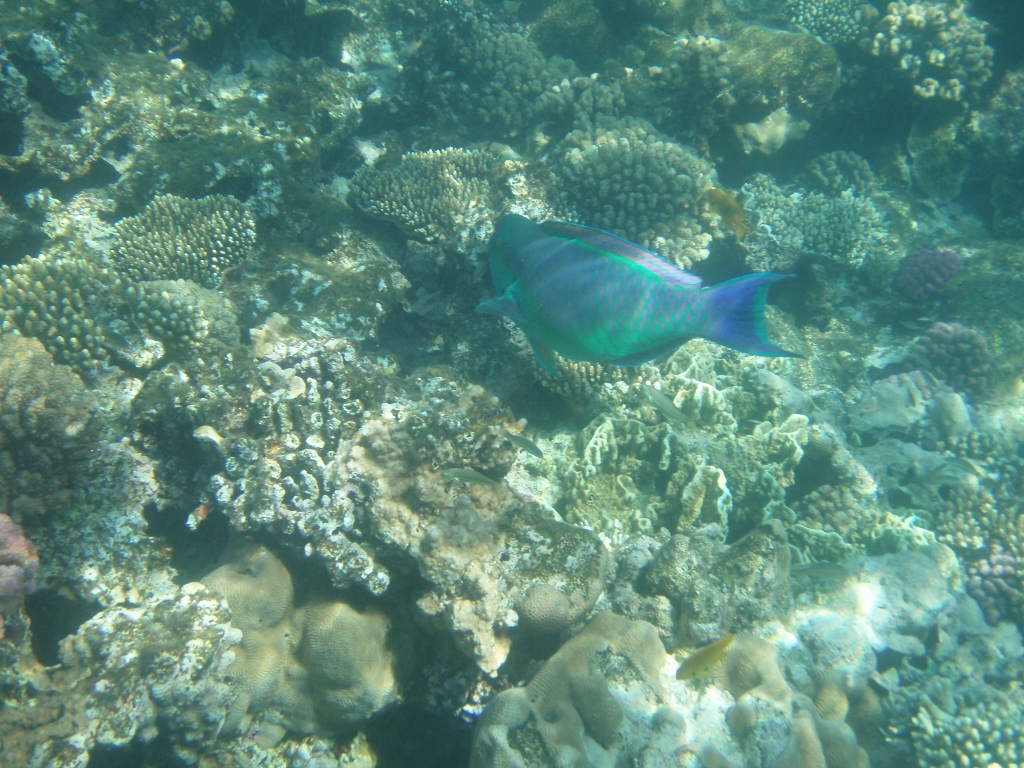 Red Sea marine life
Red Sea marine life
However, the main reason why I came to Sharm El-Sheikh was to go on a very special excursion. It involved climbing to the top of Mount Sinai and waiting for the sunrise there, followed by a visit to the Monastery of St. Catherine.
The excursion began late at night when the minibus arrived at the hotel to pick me up. Of course, I wasn’t the only one on this quite popular trip. I tried to doze off in the minibus, but it wasn’t really successful. In fact, there wasn’t much time anyway because we arrived at the Monastery of St. Catherine around 2:30 in the morning. I stepped out of the minibus into total darkness and could only follow the guide thanks to the lamp he and the other guides were using.
To reach the summit of Mount Sinai, there are two routes, both of which practically start from the Monastery of St. Catherine. The shorter, steeper and more direct route starts behind the monastery, where visitors need to climb up 3750 “steps of penitence.”
The second route, which is less steep, follows a wider path that gently ascends the mountain, although near the summit, it still requires climbing stairs. The summit is about 3.5 km from the monastery, with a height difference of about 700 m; the monastery is located at the altitude of 1584 m, while the summit of Mount Sinai is 2285 m high.
Since I was still battling a cold and hadn’t slept well enough, I decided to treat myself by signing up to ride a camel for most of the journey. I wasn’t the only one opting for this version.
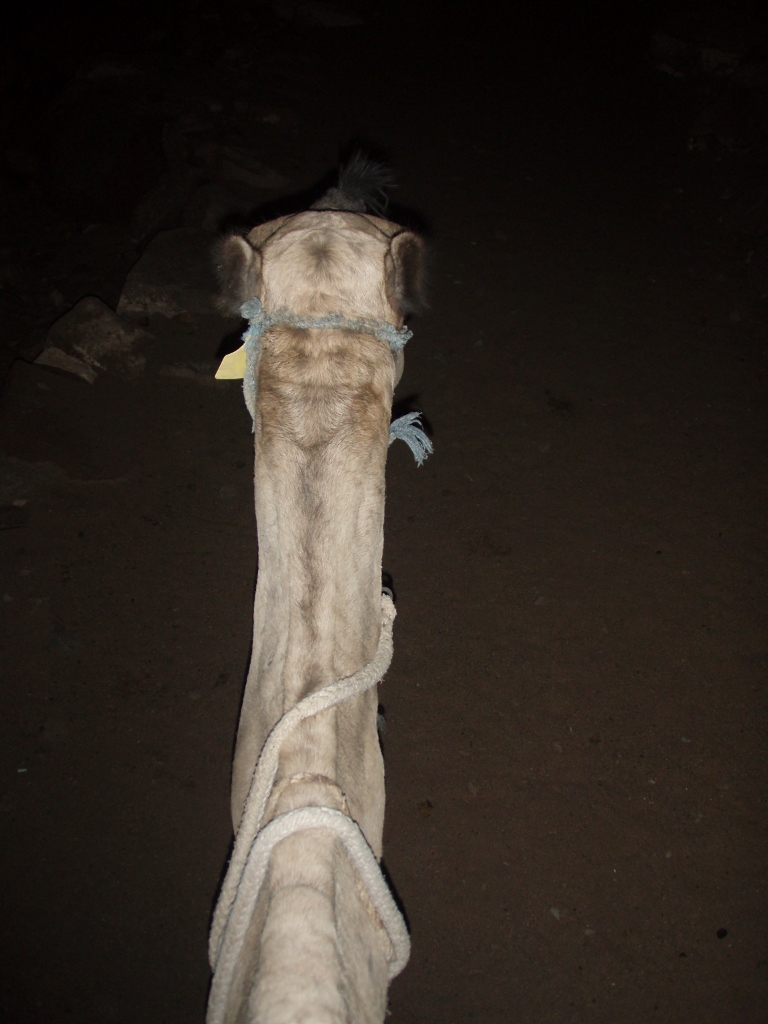 Ascending Mount Sinai on a camel
Ascending Mount Sinai on a camel
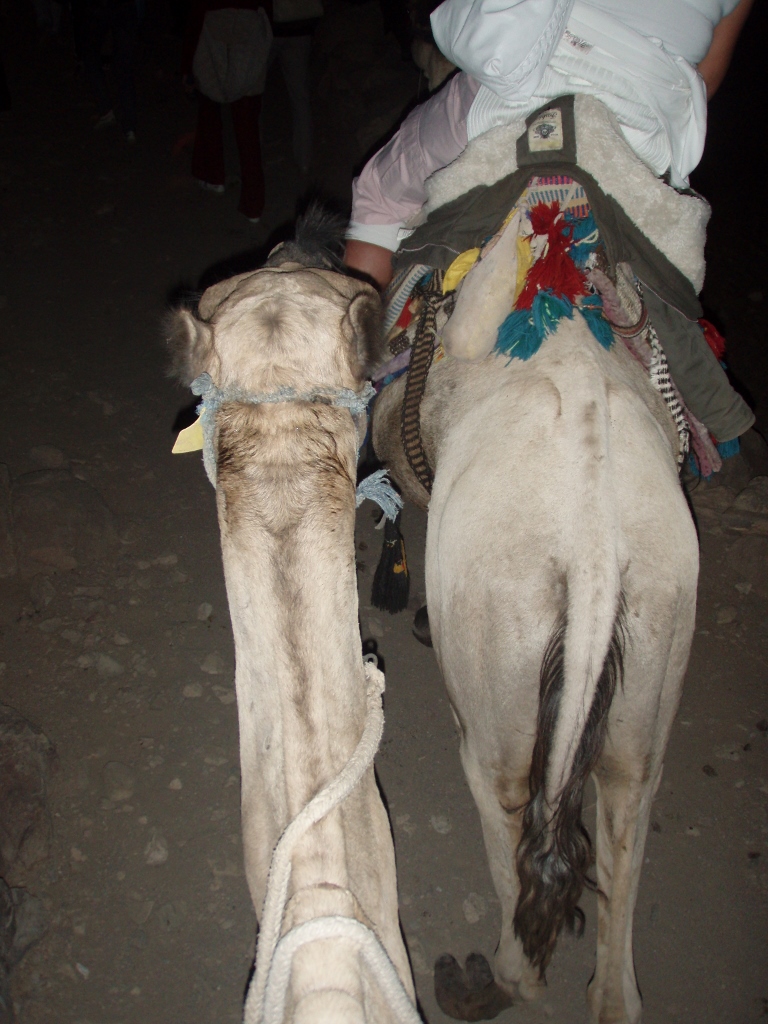 Ascending Mount Sinai on a camel
Ascending Mount Sinai on a camel
By the way, the camels are clearly visible in the previous photos because I used the flash on my camera. I was also filming with a video camera, but nothing was visible. In reality, absolute darkness still prevailed, but I didn’t need to bother about it because the camel guides were familiar with the terrain and the path, and surely had trained eyes. Visitors who were walking often carried lamps with them and further away one could occasionally see some light indicating a human settlement, small but definitely present.
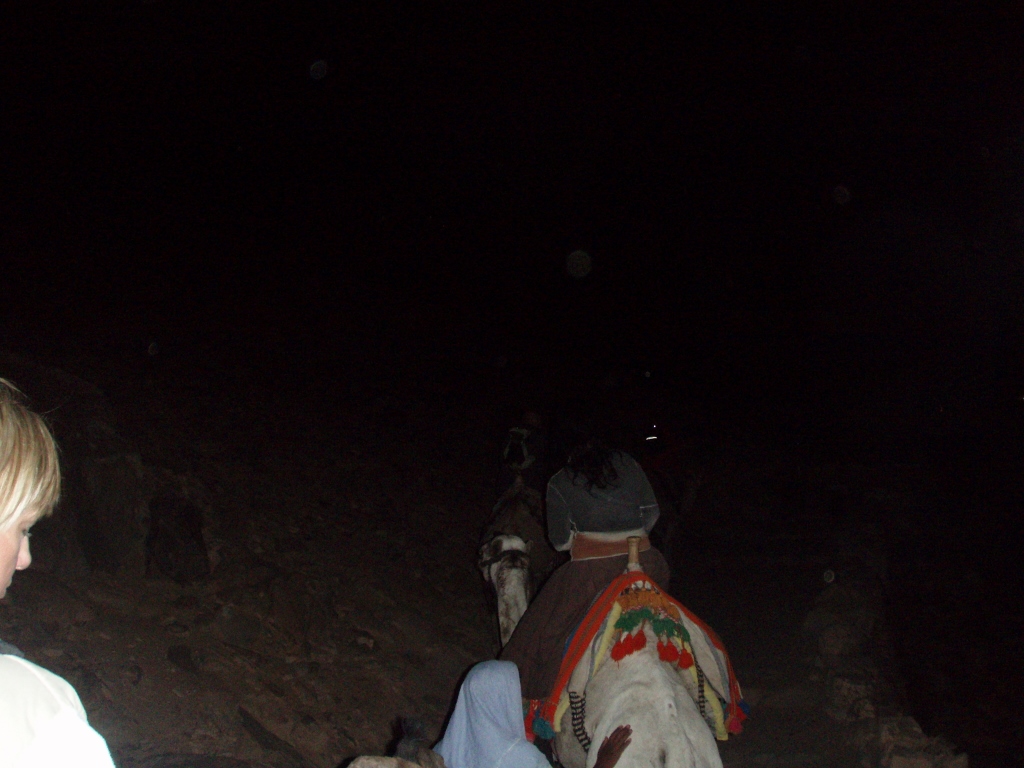 Ascending Mount Sinai on a camel
Ascending Mount Sinai on a camel
Riding the camel wasn’t particularly comfortable - everything swayed intensely and it somewhat chafed me. Nevertheless, I managed and it was definitely easier than walking. However, camels don’t go all the way to the top, but only to a certain point where the stairs begin. This presented quite a challenge for me. I often had to stop to catch my breath. As I rested, I began to notice other visitors and I even saw some much older people climbing, seemingly much more easily than me. I explained this to myself by assuming they were probably there as devout believers, while I was there out of curiosity.
Namely, the summit of Mount Sinai, often called Mountain of Moses or Jabal Mousa in Arabic, is one of the holiest places in the Torah, the Bible and the Quran, as this is where Moses received the Ten Commandments.
Mount Sinai is not the highest peak in this mountain range, but it is certainly the most significant one. When I finally reached the top, around 5:10 in the morning, the dawn was just beginning to break.
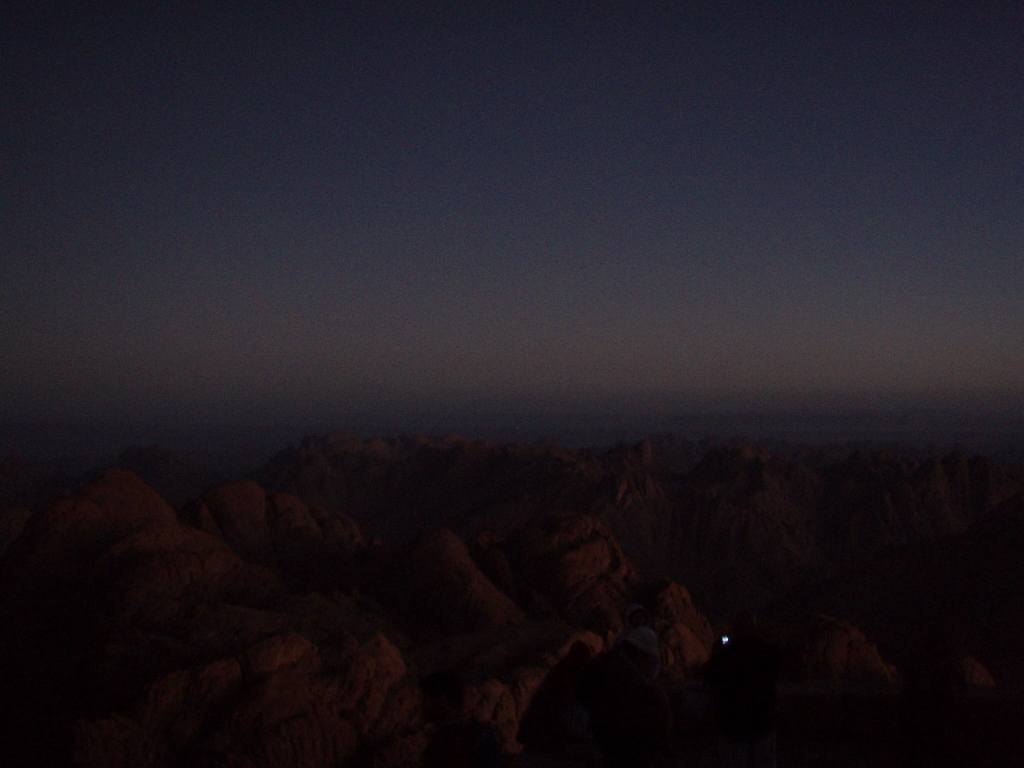 Dawn beginning to break on the top of Mount Sinai
Dawn beginning to break on the top of Mount Sinai
As the light gradually increased, I found the early morning colours fascinating. However, I must mention that I enjoyed the sky even while swaying on that camel. You see, the moon was waning, so the sky was filled with a large number of stars and I thoroughly enjoyed it. Now, that enjoyment simply shifted to another topic.
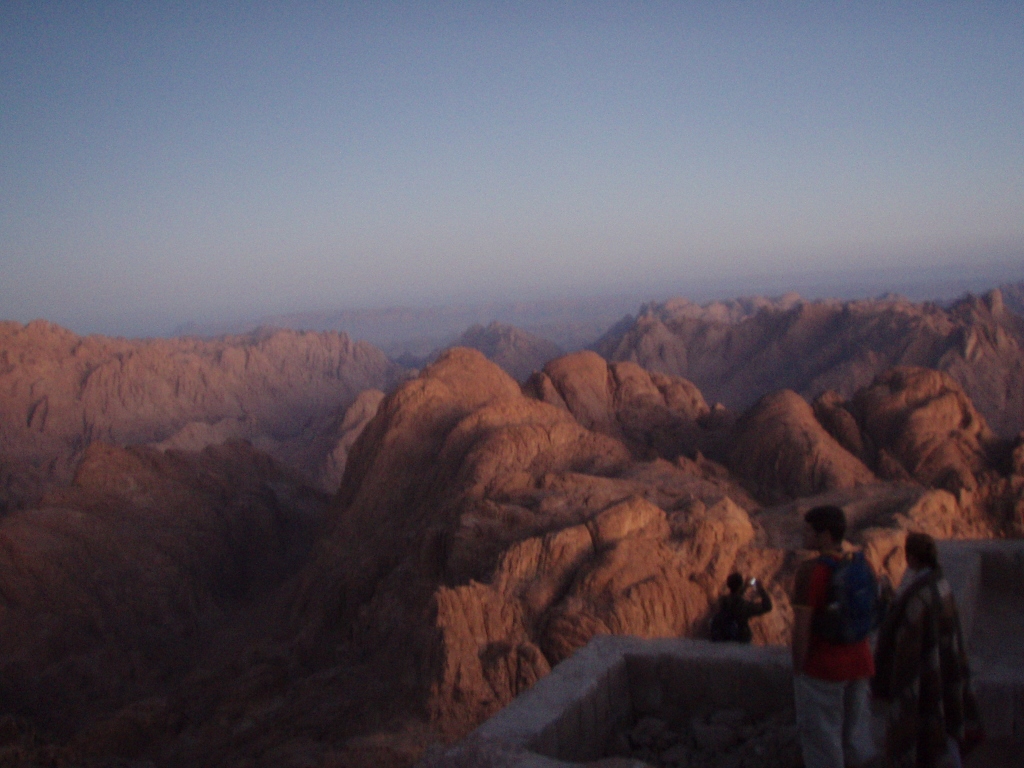 Dawn on the top of Mount Sinai
Dawn on the top of Mount Sinai
There was a large crowd on the top, but I managed to find a good spot for myself. Everyone gathered here to witness the sunrise and though I wasn’t in the “front row,” I knew the sun would eventually shed its rays upon me.
In the meantime, I took a photo of the Greek Orthodox chapel built here in 1934 on the foundations of a church from the 16th century. It practically covers the area believed by tradition to have been the source of the biblical stone tablets inscribed with the Ten Commandments.
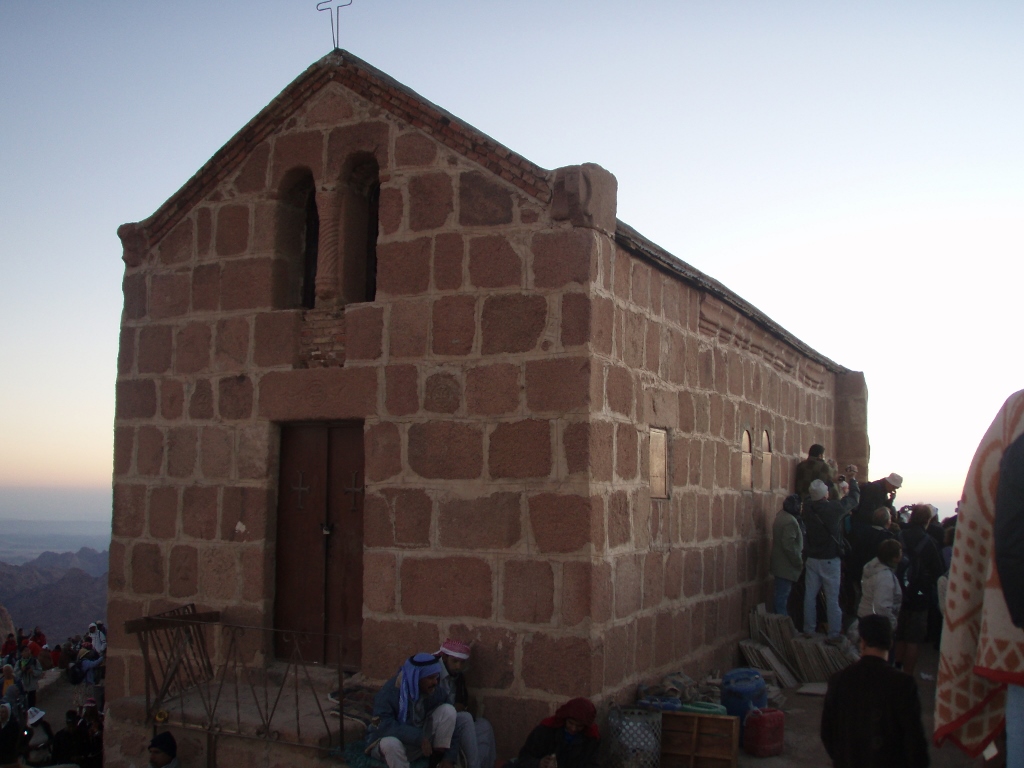 Chapel on the top of Mount Sinai
Chapel on the top of Mount Sinai
Behind me, there was a small mosque, but while I was taking photos of the chapel, I didn’t find it convenient to turn around and later, I must admit, I forgot to capture it. In any case, both the chapel and the mosque were closed.
However, the “souvenir shop” was open for business.
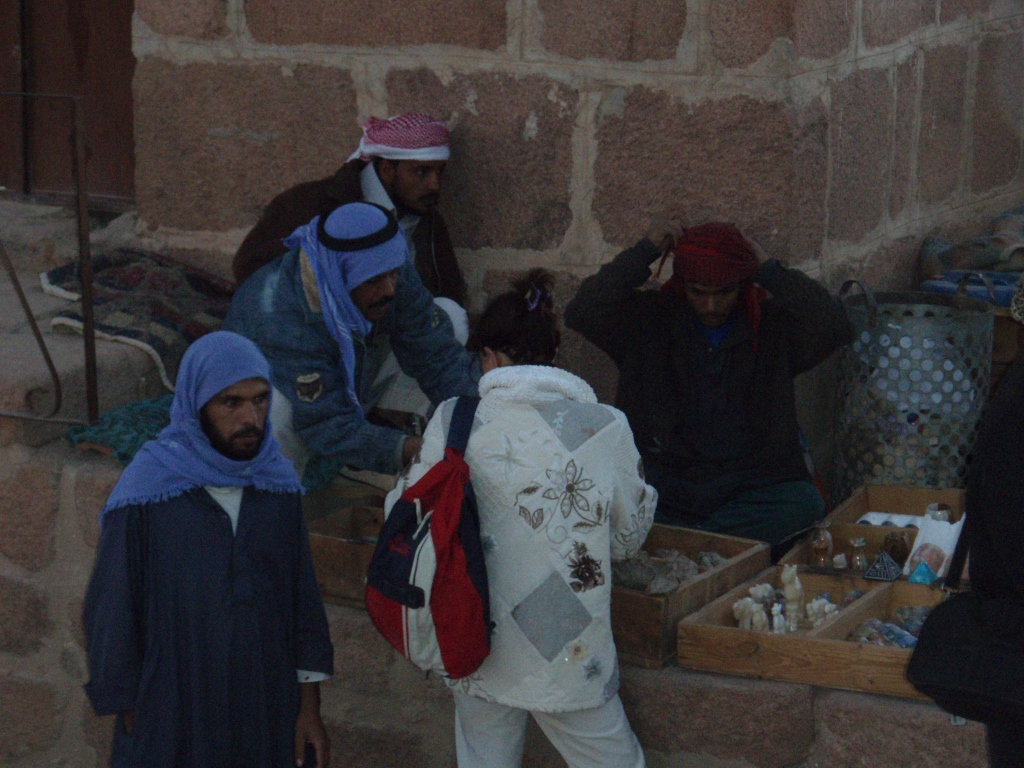 Detail from the top of Mount Sinai
Detail from the top of Mount Sinai
As I had expected, at some point, the sun appeared above the horizon line and began to illuminate the landscape where I was situated.
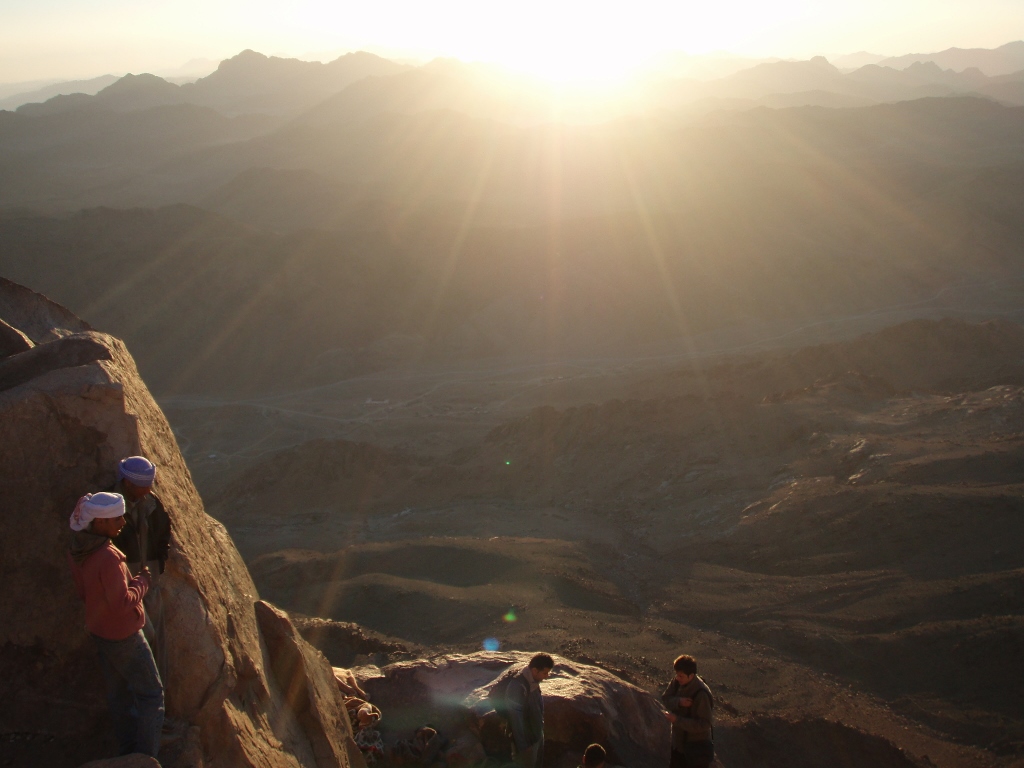 Sun coming out and shining on the top of Mount Sinai
Sun coming out and shining on the top of Mount Sinai
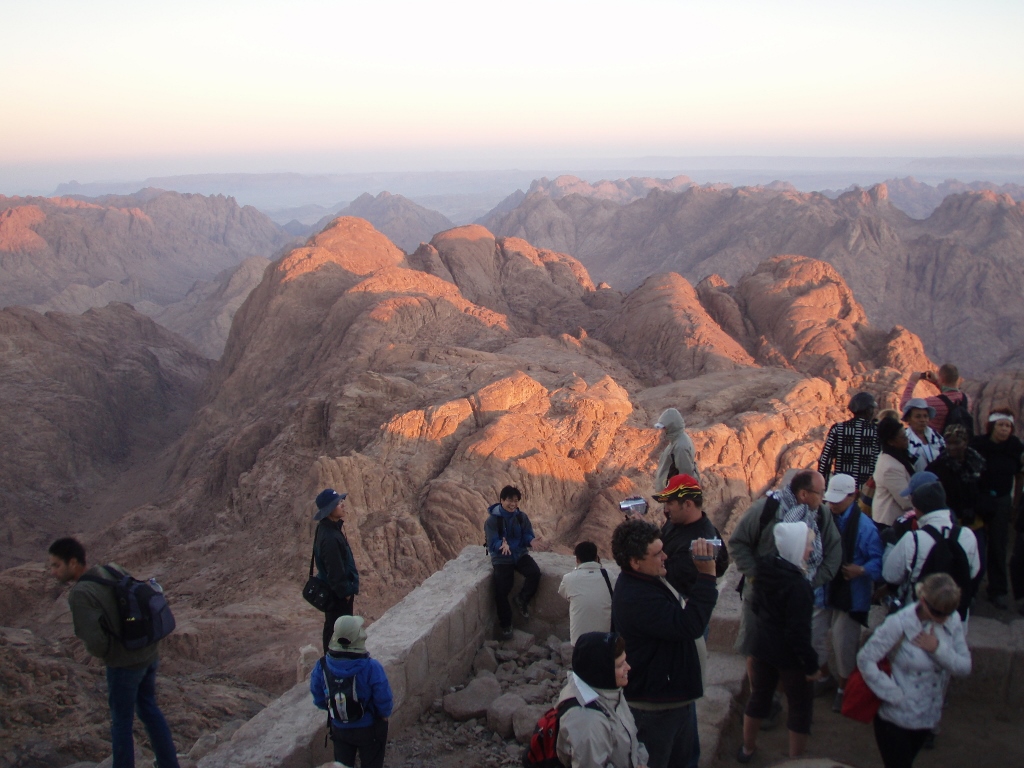 Sunrays are lighting up more and more the rocky mountains in the Sinai Peninsula
Sunrays are lighting up more and more the rocky mountains in the Sinai Peninsula
Since there were many people on the top, it wasn’t a problem to find someone to take a photo of me and, of course, I reciprocated.
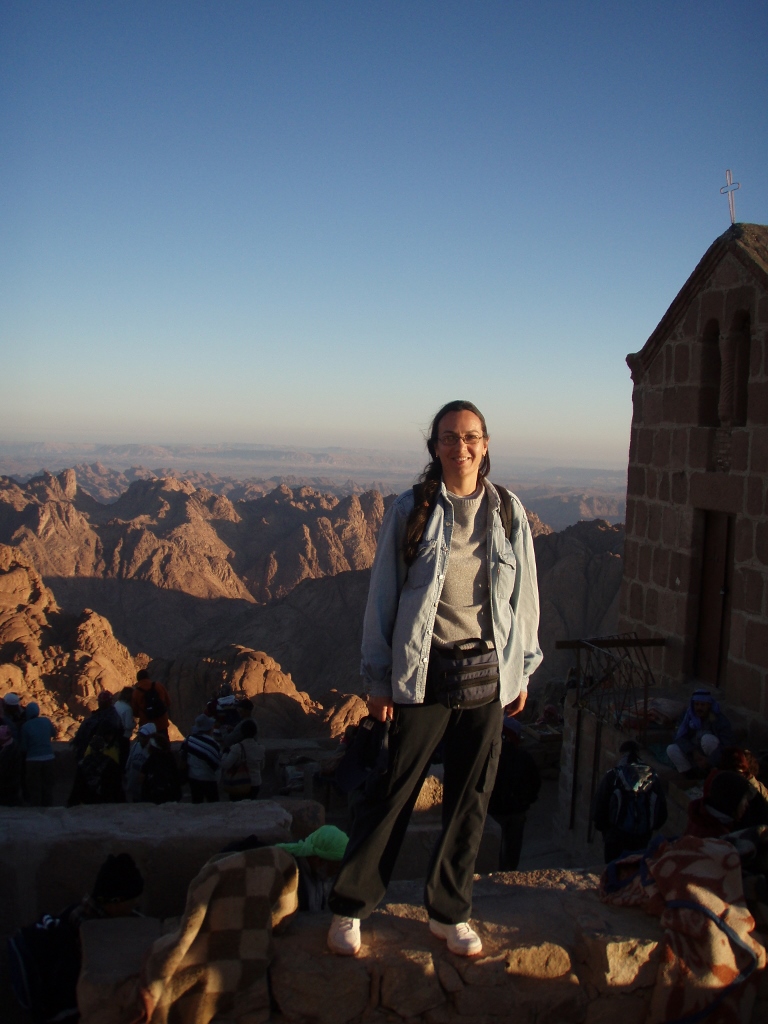 On the top of Mount Sinai
On the top of Mount Sinai
When the sun began to peek out, there were lots of “aaahs” and “ooohs,” and when it fully rose above the horizon, no one was interested anymore and everyone just wanted to descend as quickly as possible, so they started to move. Then the “front row” for watching the sunrise became empty and I could walk up to it, but there wasn’t really a better view than from where I had sat. So, I just took a photo of the chapel’s bell tower and I was ready to start descending the mountain myself.
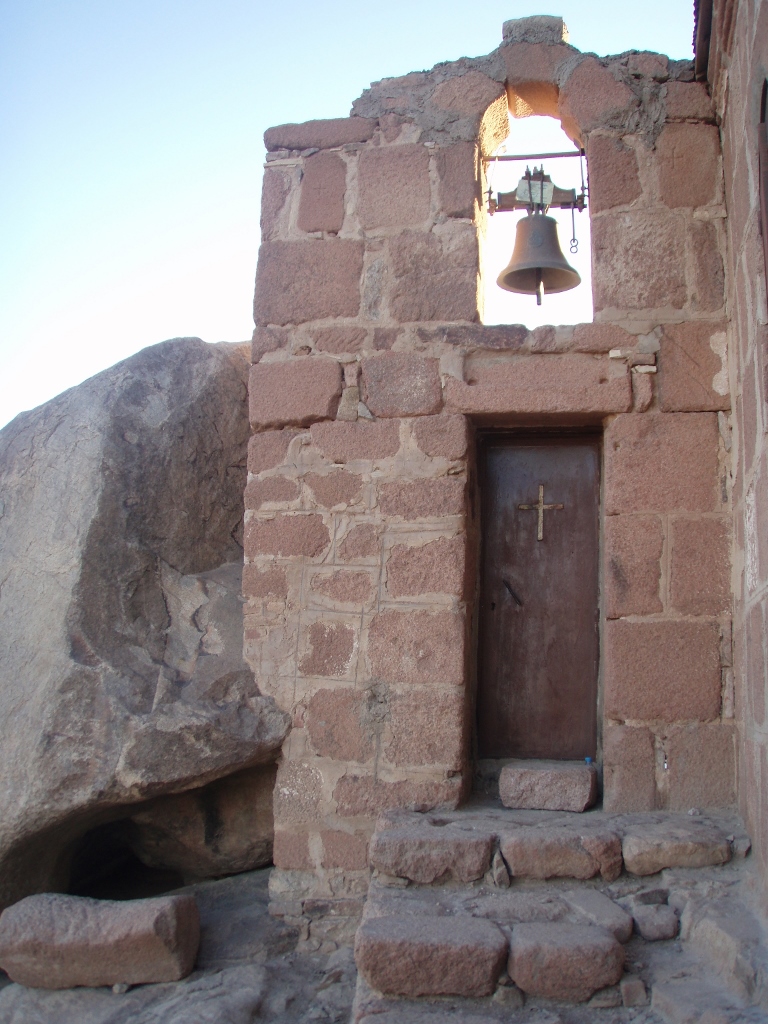 Bell tower of the chapel on the top of Mount Sinai
Bell tower of the chapel on the top of Mount Sinai
By 6:10, the large descent was well on its way.
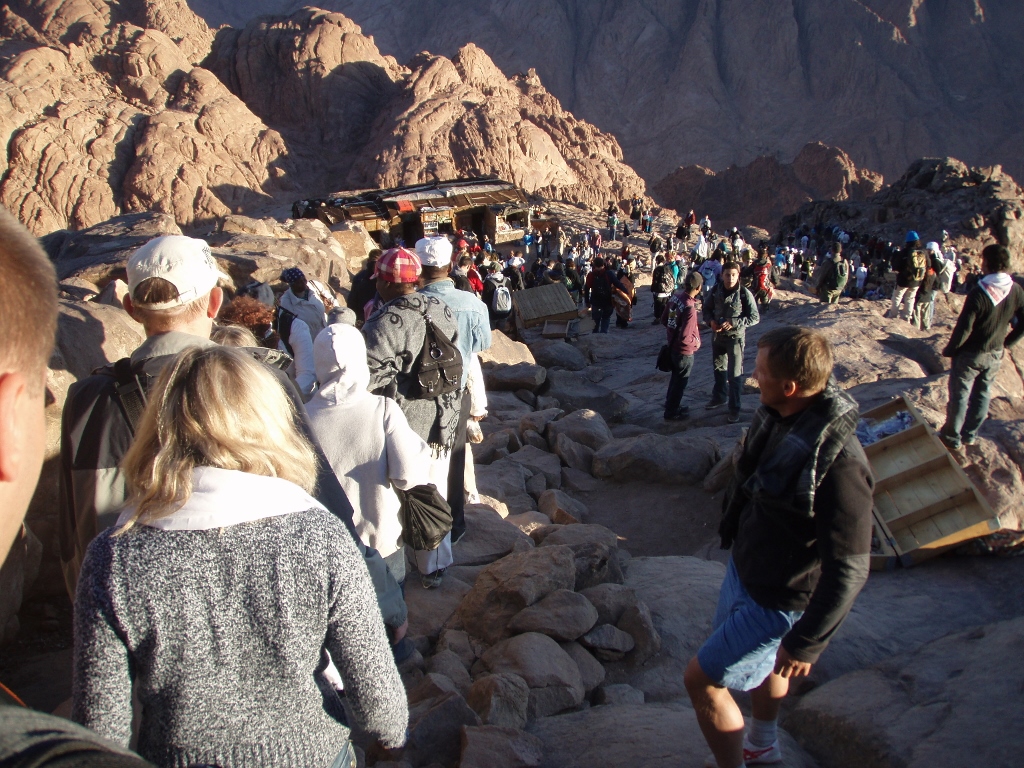 Descending the top of Mount Sinai
Descending the top of Mount Sinai
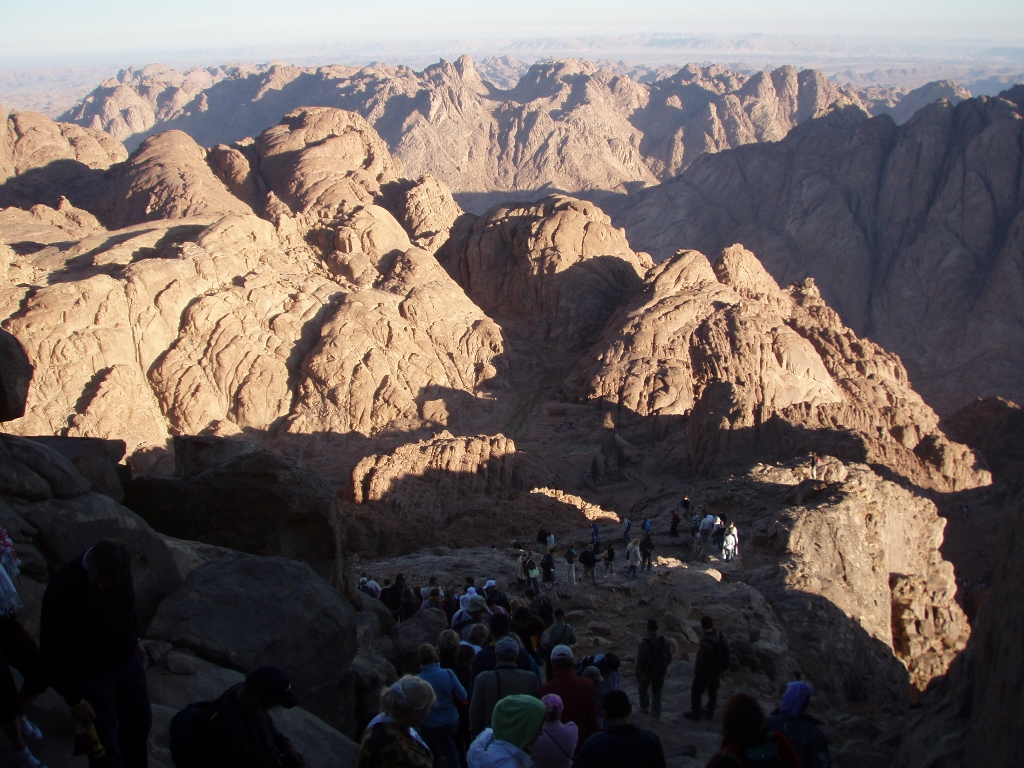 Descending the top of Mount Sinai
Descending the top of Mount Sinai
I was delighted with the landscapes surrounding me and I also occasionally exchanged mutual photo-taking with people I met along the way.
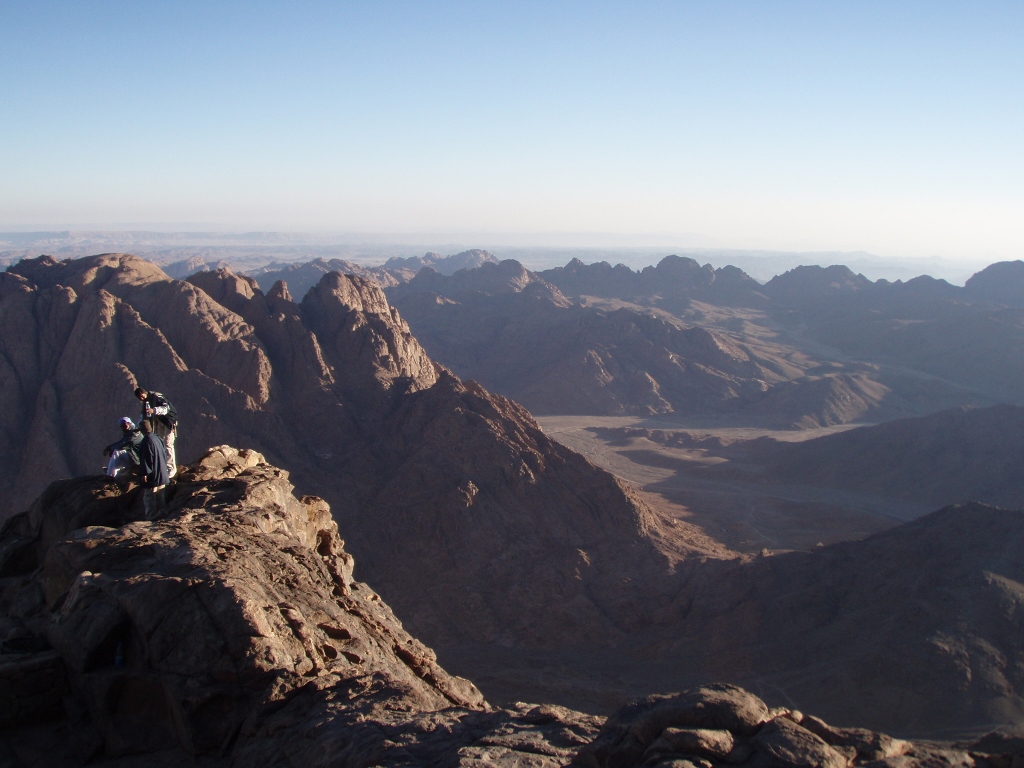 View from the top of Mount Sinai
View from the top of Mount Sinai
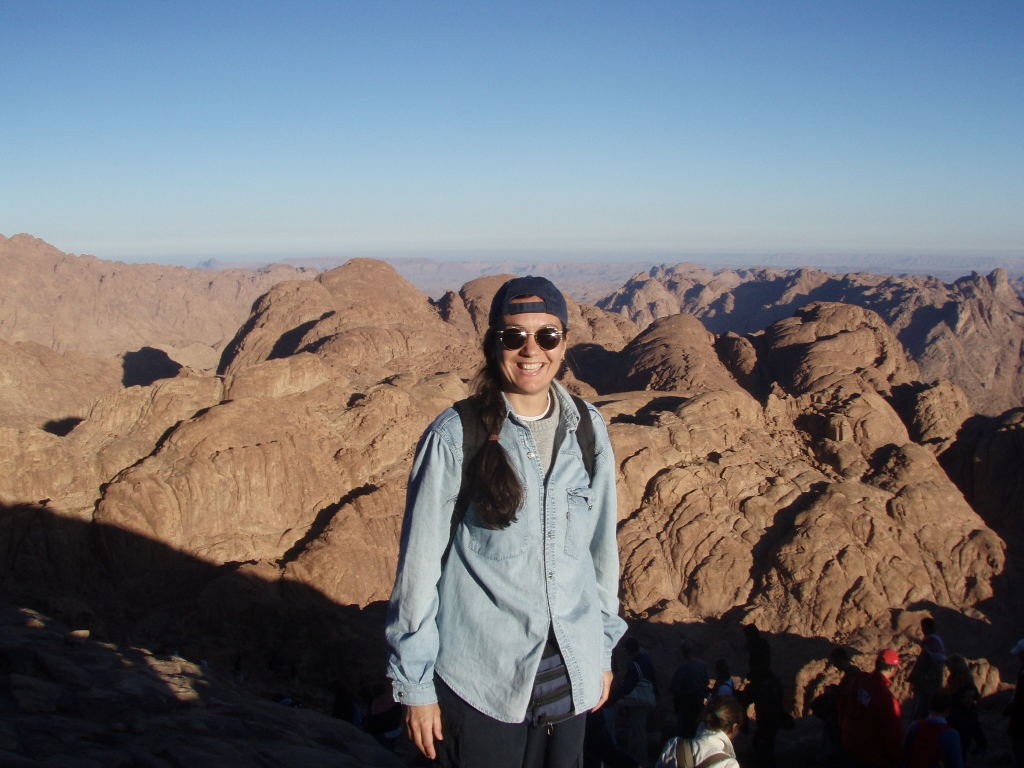 Close to the top of Mount Sinai
Close to the top of Mount Sinai
Now, the first thing to do was to descend via the stairs and everyone had to do that part on foot.
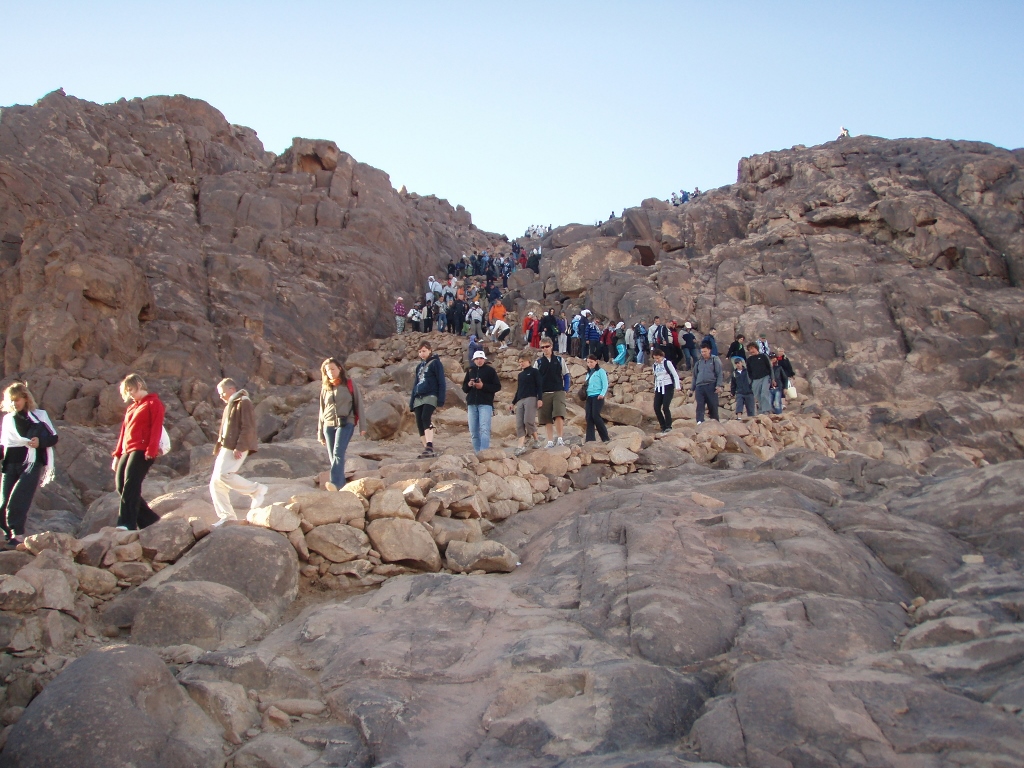 Descending the top of Mount Sinai
Descending the top of Mount Sinai
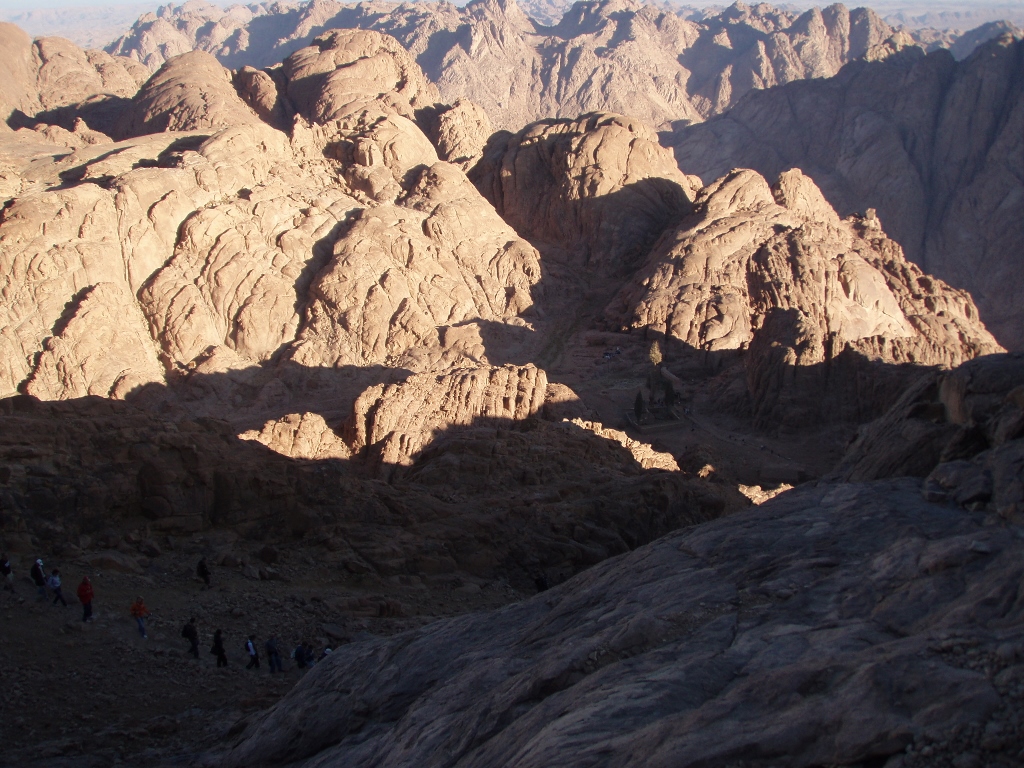 Descending the top of Mount Sinai
Descending the top of Mount Sinai
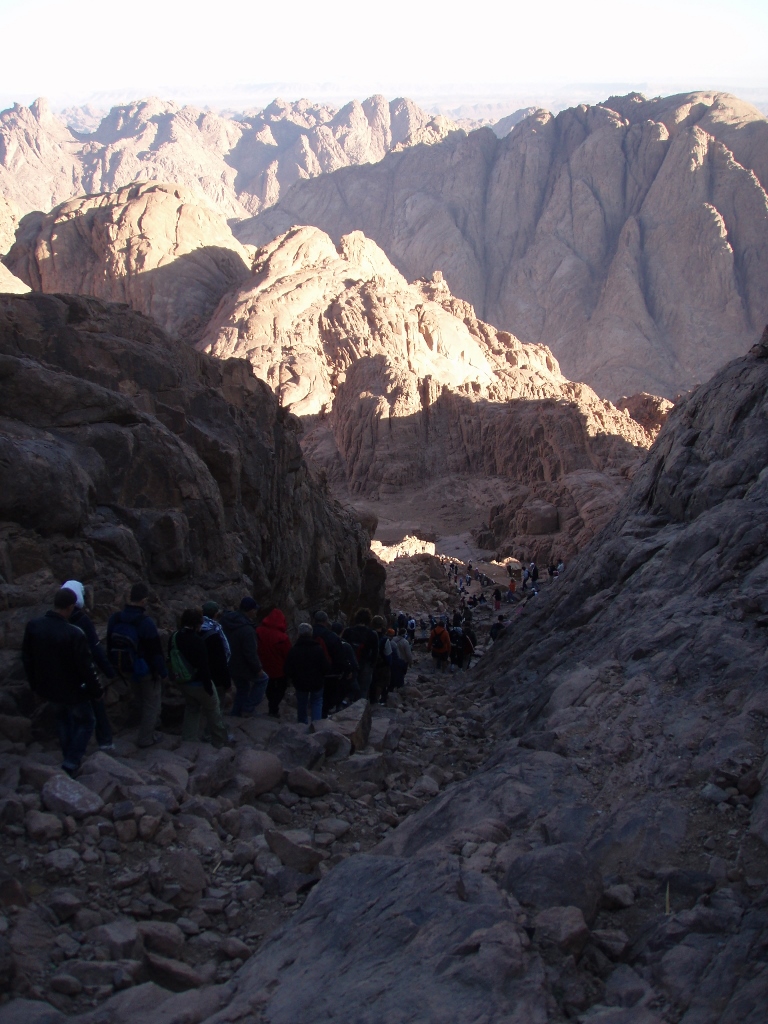 Descending the top of Mount Sinai
Descending the top of Mount Sinai
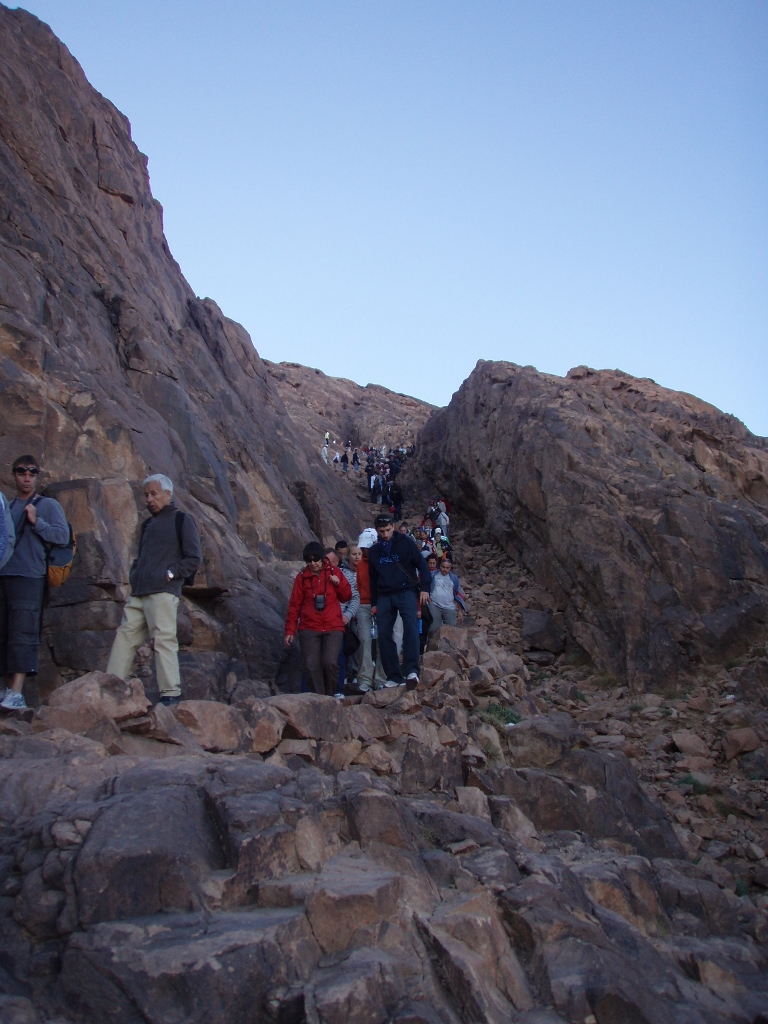 Descending the top of Mount Sinai
Descending the top of Mount Sinai
Then, the route led to a clearing where the camels were waiting parked. As I have already mentioned, I rode a camel up to this point, but on the way back, I decided to walk the entire time.
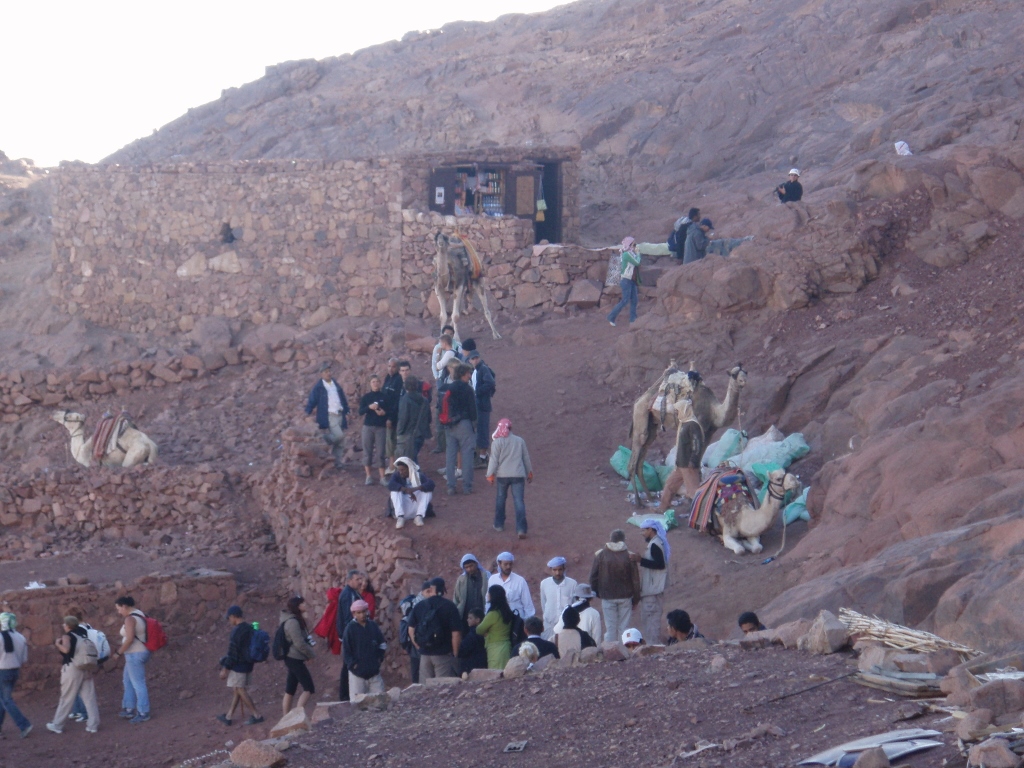 End of the stairs and the beginning of a wider path
End of the stairs and the beginning of a wider path
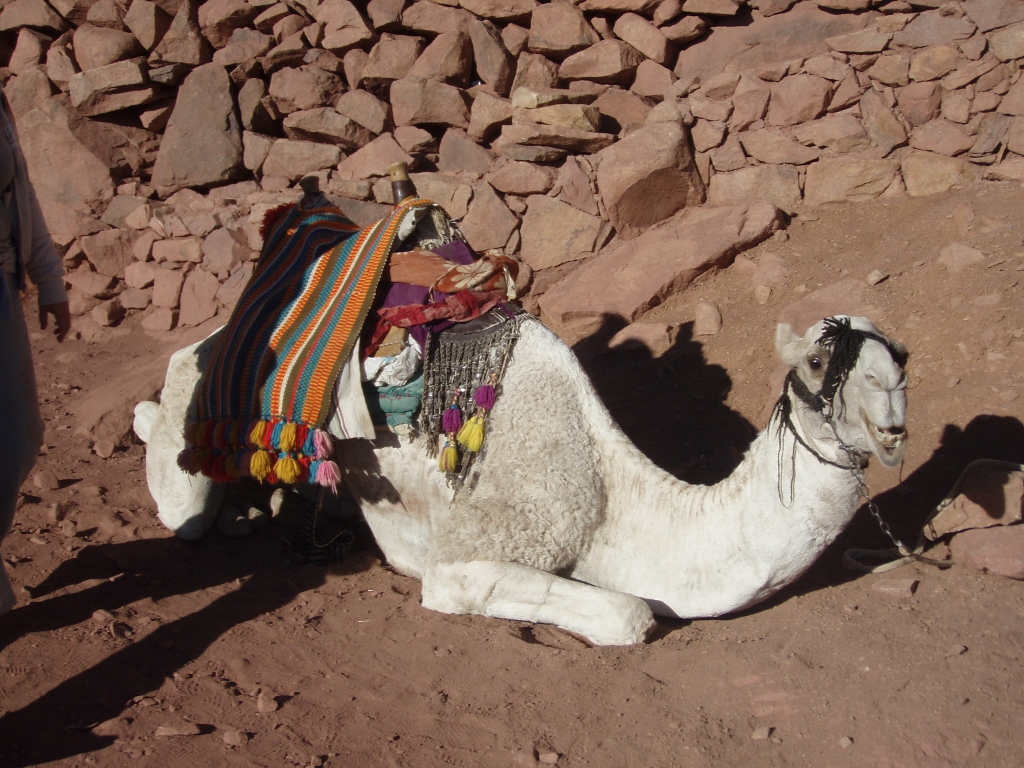 Camel waiting for the ride
Camel waiting for the ride
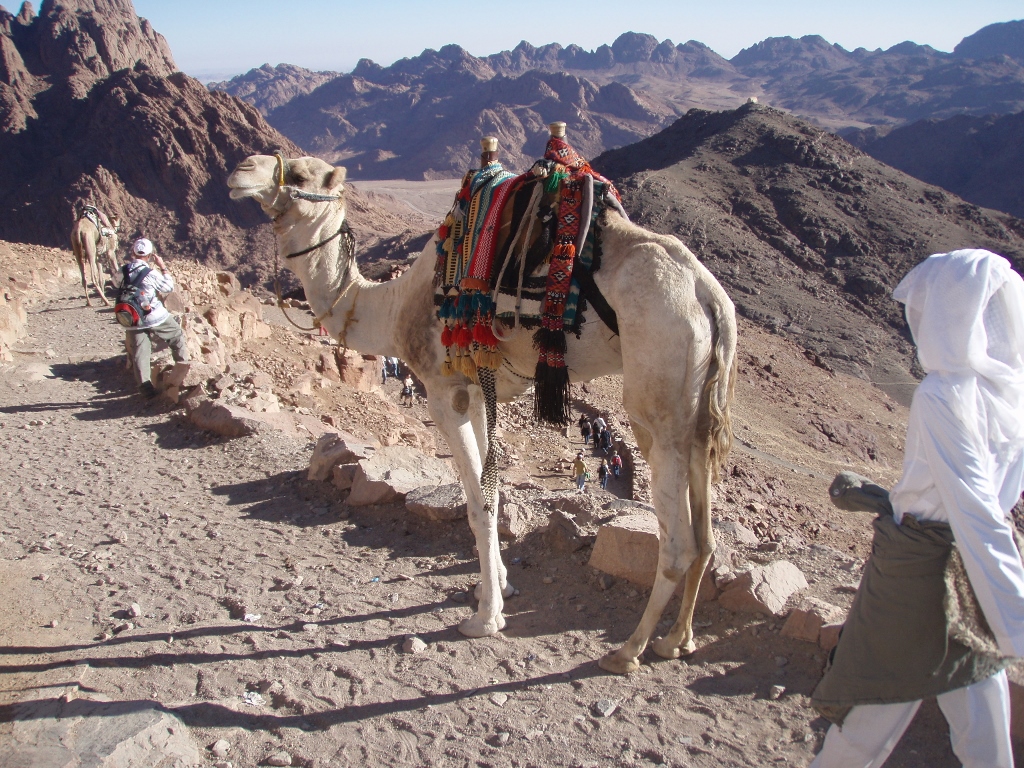 Camel waiting for the ride
Camel waiting for the ride
I came across another spot where I felt like having my photo taken, so I then found someone to help me out with this.
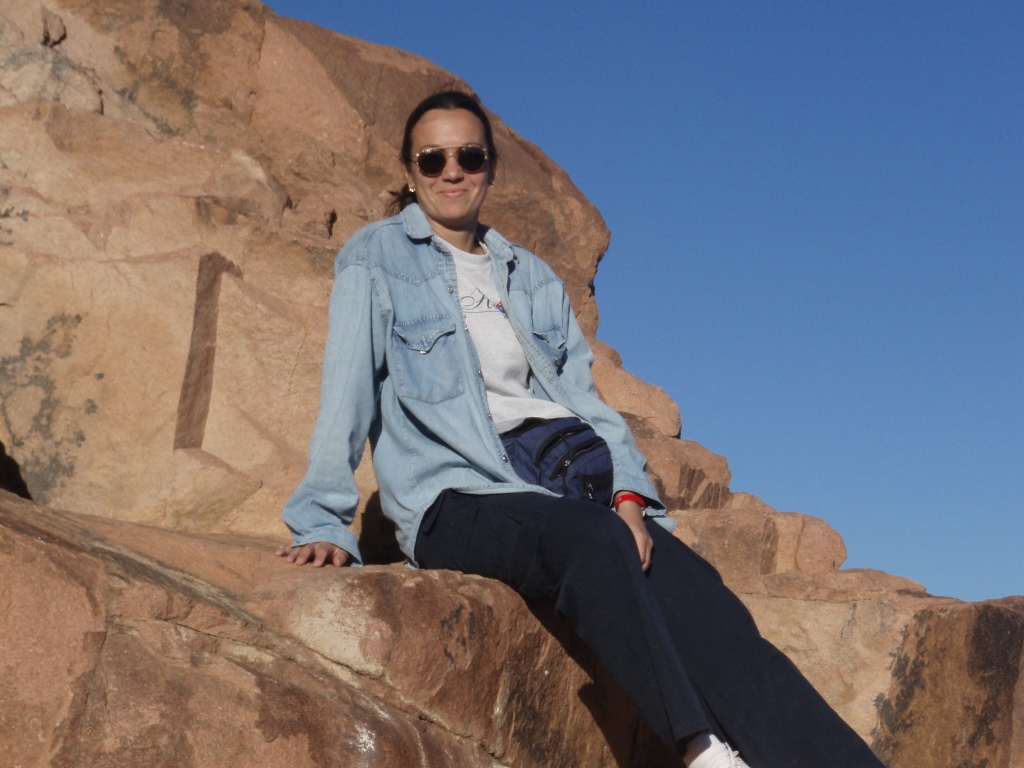 At the end of the stairs
At the end of the stairs
In the meantime, it warmed up, so I soon changed into shorts, which felt comfortable. On the other hand, descending down the steep stairs was very challenging for me because I walked poorly and stubbed my toes, which ended up complicating things quite a bit. Upon returning to Belgrade, I even lost a toenail.
But walking on the wider path was much easier.
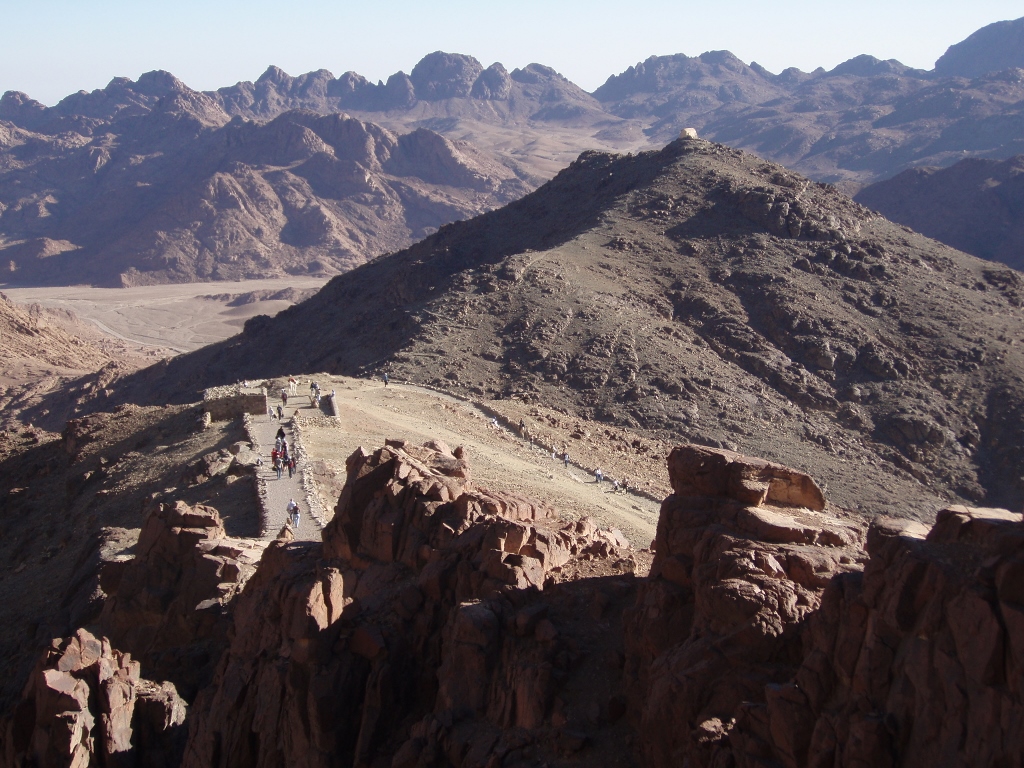 Mount Sinai
Mount Sinai
Here is a short video that in a different way illustrates the descent from Mount Sinai:
No matter how inhospitable Mount Sinai may seem, with its rocky terrain, there are still people who live there. It’s amazing how people decide to live in such places. I wondered if there were no better places to live and what prompted the ancestors of these inhabitants to settle here.
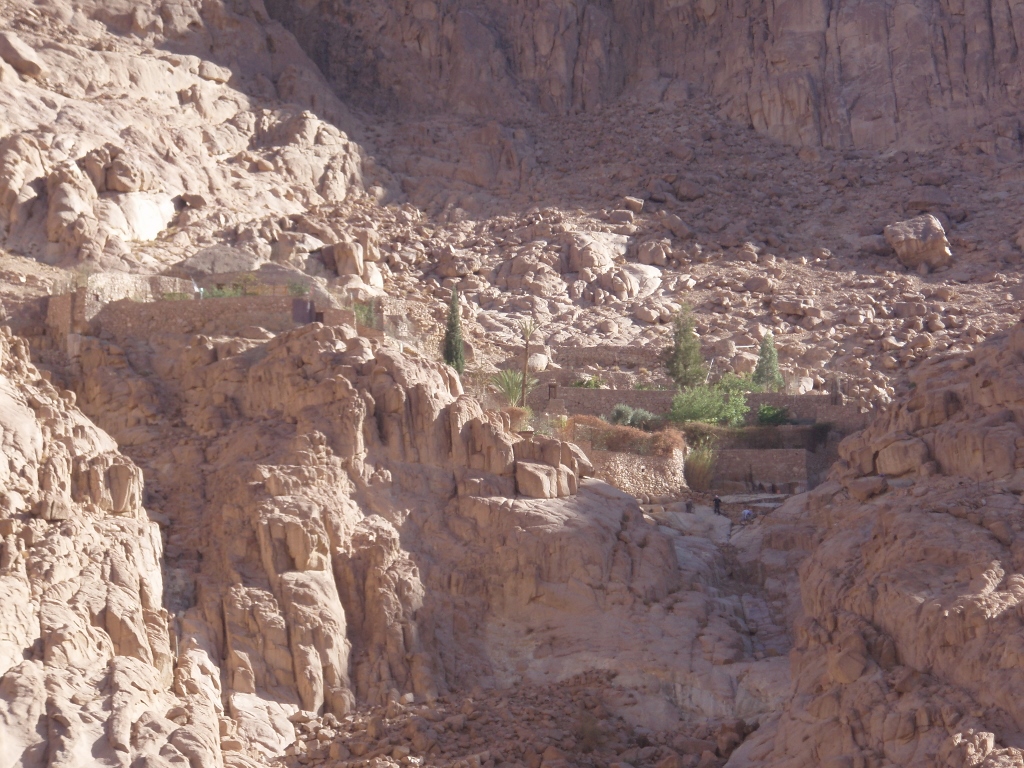 Human settlement on Mount Sinai
Human settlement on Mount Sinai
However, it’s not only the local residents who live in this area, but also the monks from the Monastery of St. Catherine, which belongs to the Greek Orthodox Church. In the (Catholic) Christian world, the monastery is considered second in importance, right after the Vatican. However, despite being a Christian monastery, the place is considered holy in Christianity, Islam and Judaism, and due to its significance, it is included on the UNESCO’s World Heritage List.
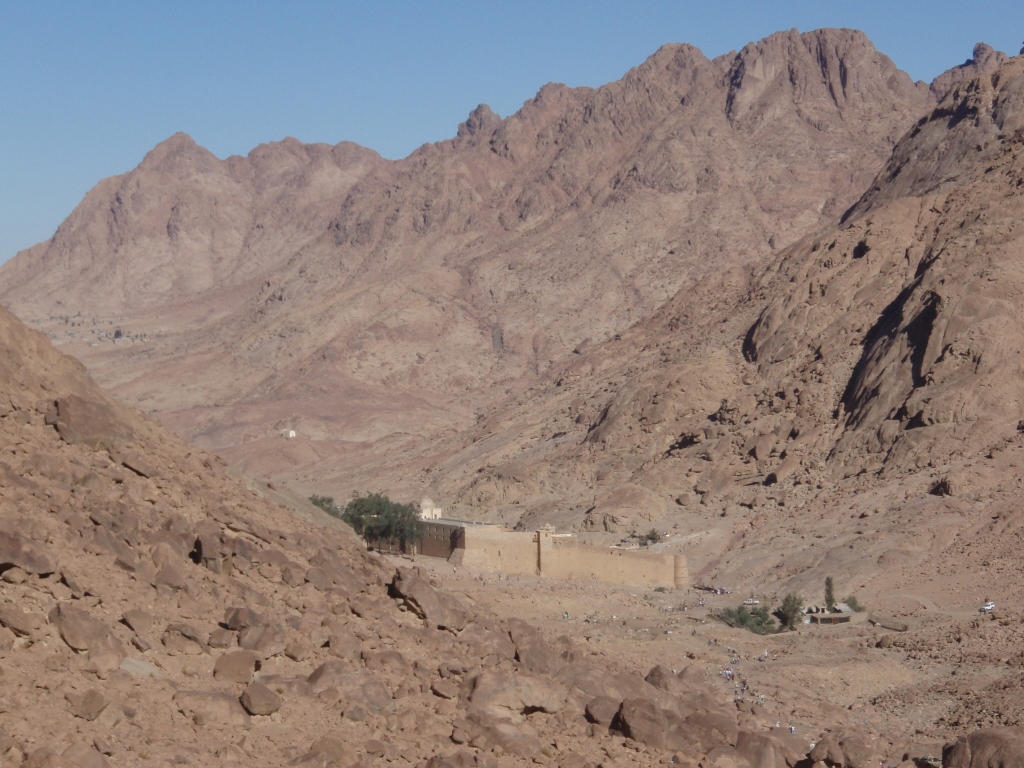 St. Catherine’s Monastery
St. Catherine’s Monastery
The monastery was founded between 548 and 565, making it the oldest continuously inhabited Christian monastery in the world. It was built by order of the Byzantine Emperor Justinian I (482-565) with the idea of enclosing the Burning Bush, from which an angel first appeared to Moses and then the Lord himself.
In fact, this is a monastery complex and the first building on this site, a chapel dedicated to the Mother of God, was built in 330 by Empress Helena or Saint Helena (246/48-330), the mother of Emperor Constantine the Great.
During the construction of the monastery in the 6th century, the main monastery church was built and dedicated to the Transfiguration of the Lord, while the monastery also includes 12 smaller chapels. All of this is surrounded by high walls dating back to the 6th century.
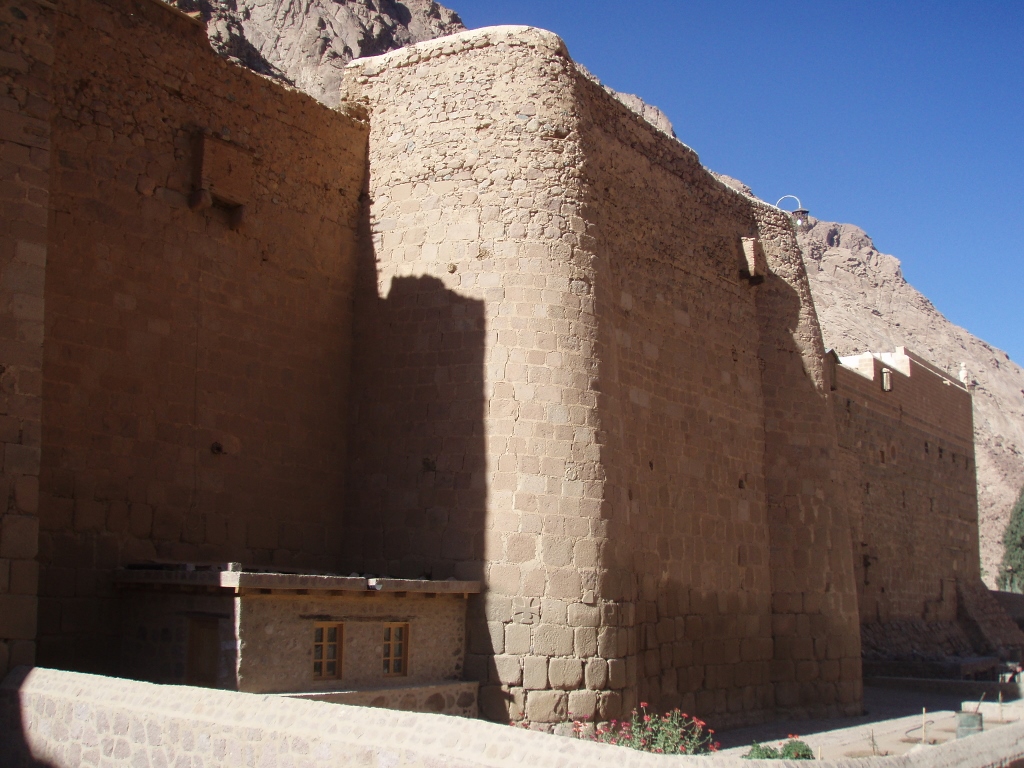 St. Catherine’s Monastery, a detail
St. Catherine’s Monastery, a detail
Certainly, the longevity of the monastery doesn’t mean that everything remains as it was originally. On the walls, you can see both the original stonework and stones that have been added over time.
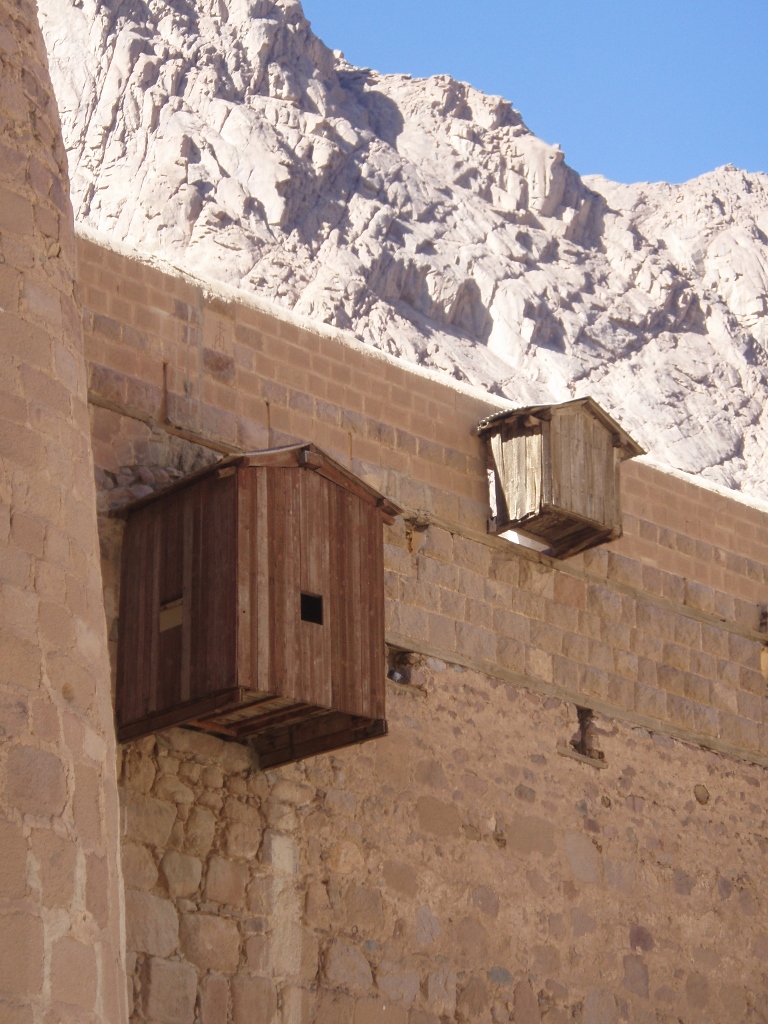 St. Catherine’s Monastery, a detail
St. Catherine’s Monastery, a detail
Since it was crowded, I first went to see some peripheral parts of the monastery, like the garden, and later I went to the heart of the monastery.
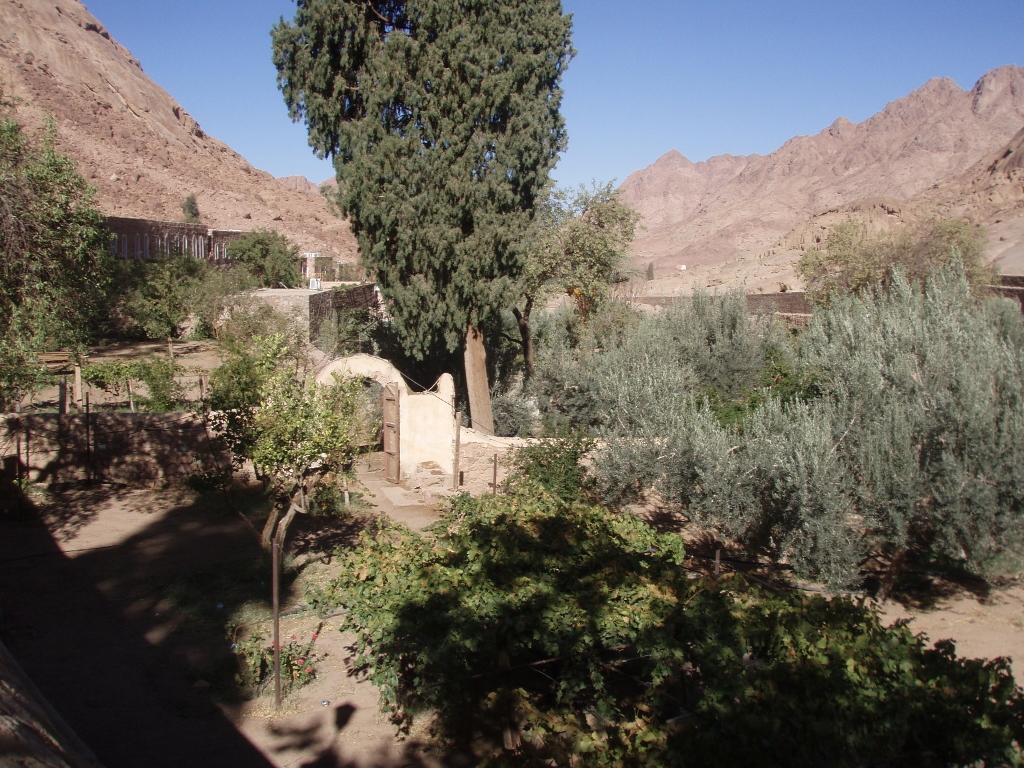 St. Catherine’s Monastery, a detail
St. Catherine’s Monastery, a detail
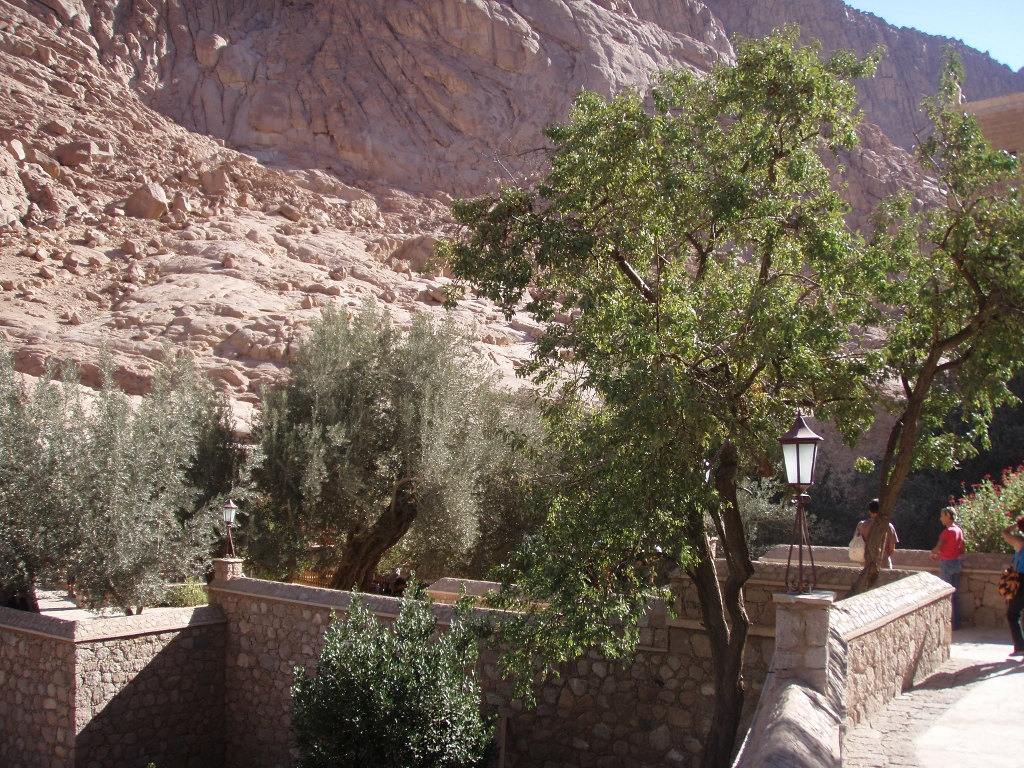 St. Catherine’s Monastery, a detail
St. Catherine’s Monastery, a detail
Within the garden, there is the Chapel of Saint Tryphon, where the remains of the monks who lived here are kept. Specifically, the chapel is on the upper floor, while the ossuary is below it.
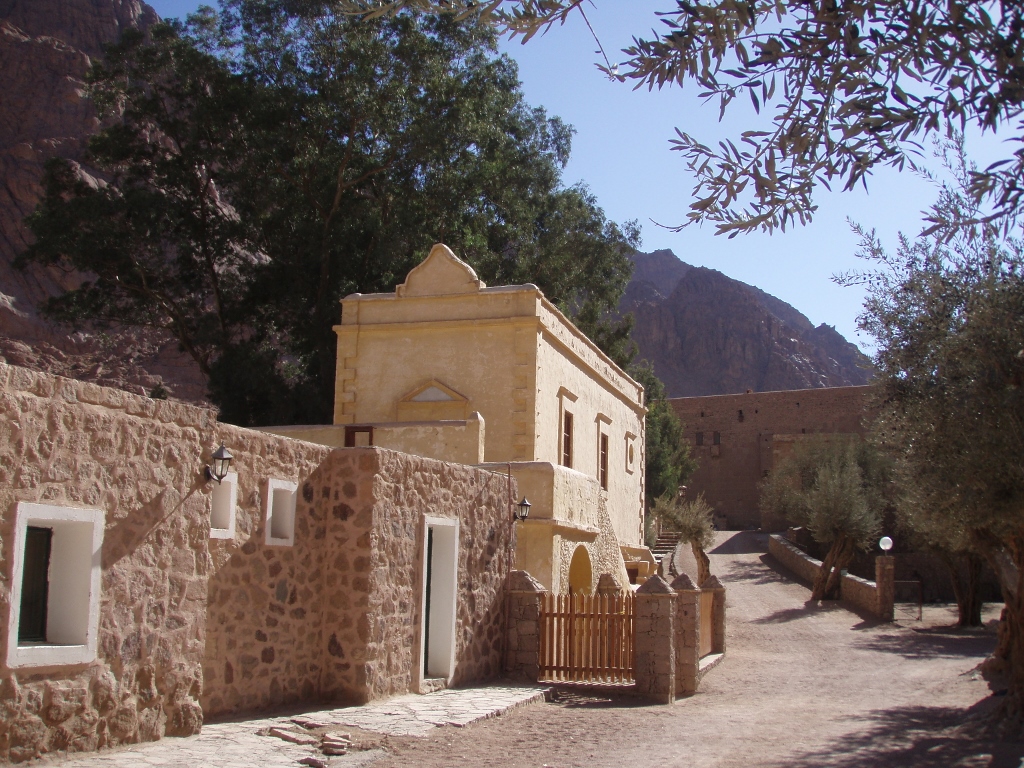 St. Catherine’s Monastery, a detail
St. Catherine’s Monastery, a detail
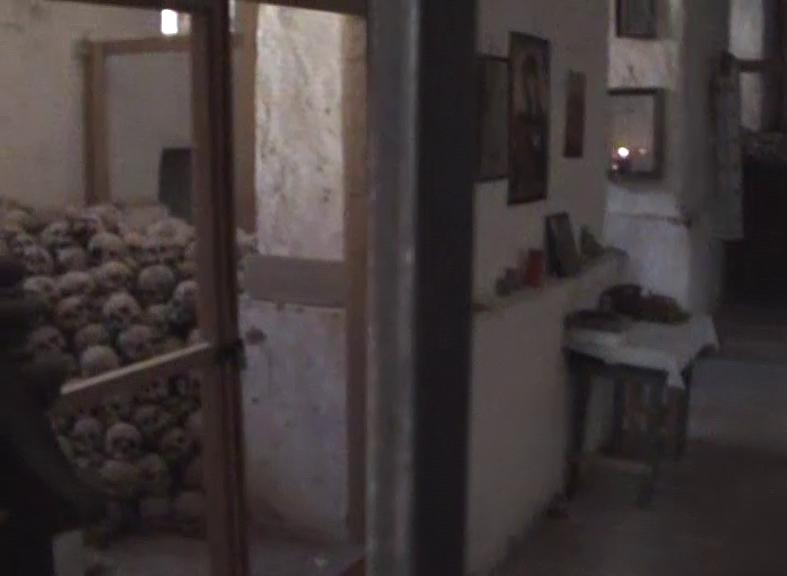 St. Catherine’s Monastery, a detail
St. Catherine’s Monastery, a detail
Upon entering the main part of the monastery, among other things, you can see the bell tower from 1871, which houses the bells that Imperial Russia donated to the monastery at the time.
Interestingly, right next to the bell tower, you can see a white tower, which is actually a minaret, since to the west of the main monastery church, the catholicon, there is also a mosque that was converted in the 11th century, having previously served as a refectory since the 6th century. The minaret is designed not to protrude too much and is not round. In the next photo, the bell tower of the church can be seen on the left side, while right behind it, there is the white minaret.
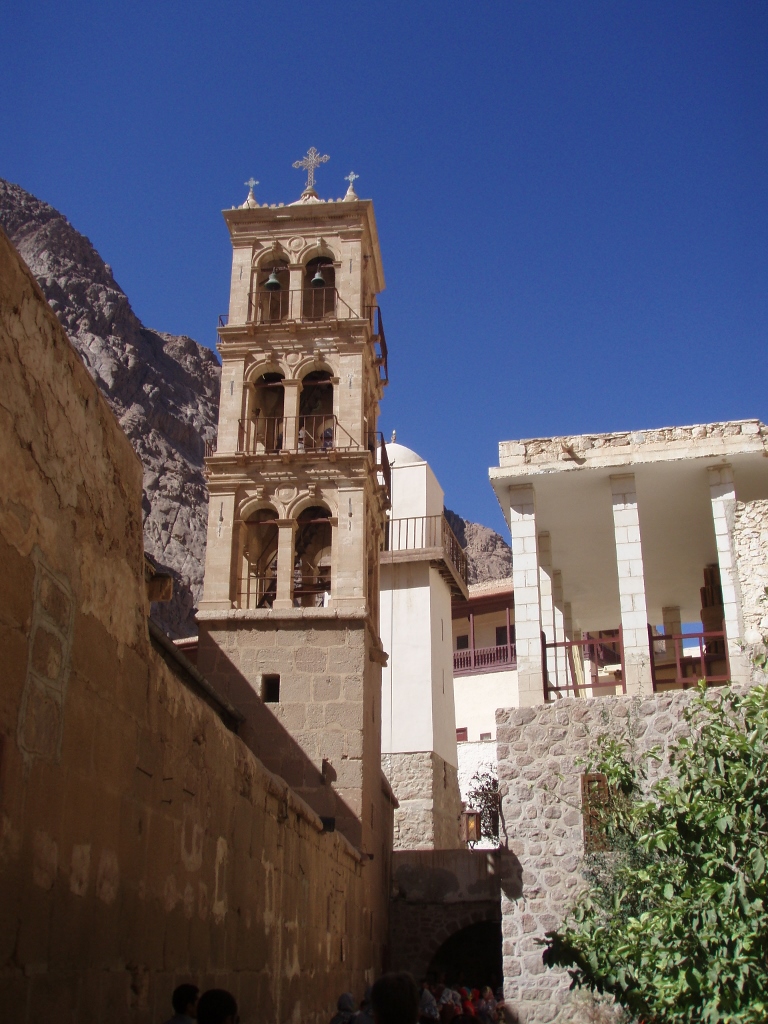 St. Catherine’s Monastery, a detail
St. Catherine’s Monastery, a detail
To the right of the minaret is the Well of Moses, where Moses first saw and met his wife. The water from the well is still used today and it requires a pump. Previously, a manually operated pump was used, but today the water is extracted mechanically.
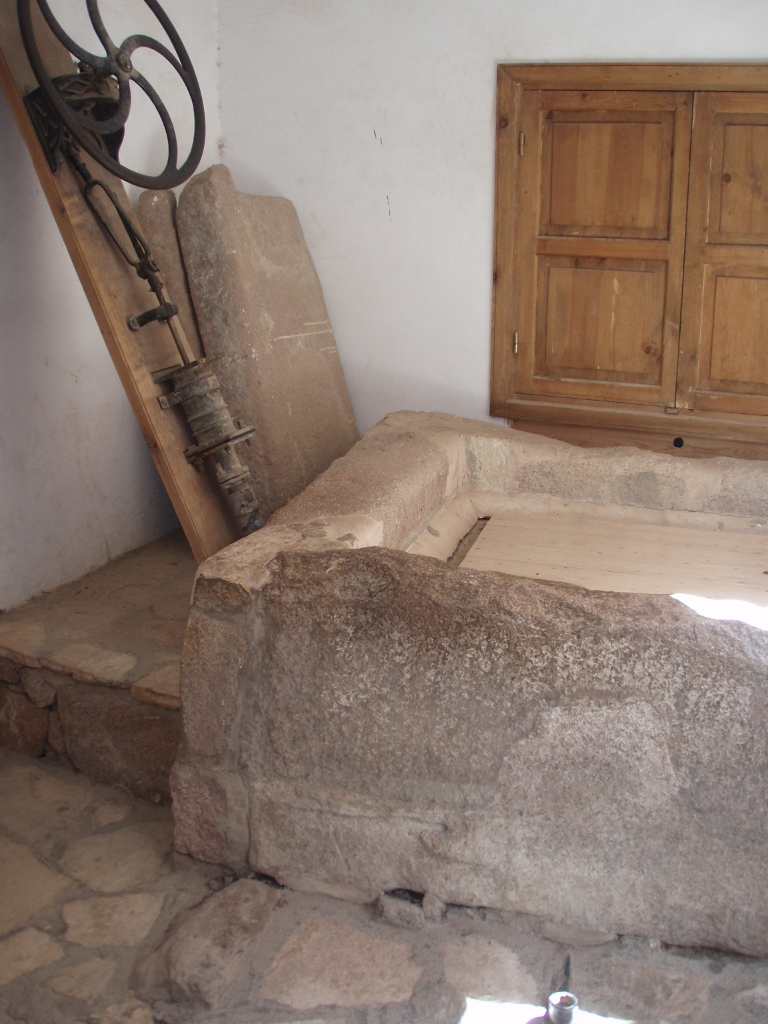 St. Catherine’s Monastery, a detail
St. Catherine’s Monastery, a detail
By the way, it is not easy to take photos here because the passages are narrow and there were many people.
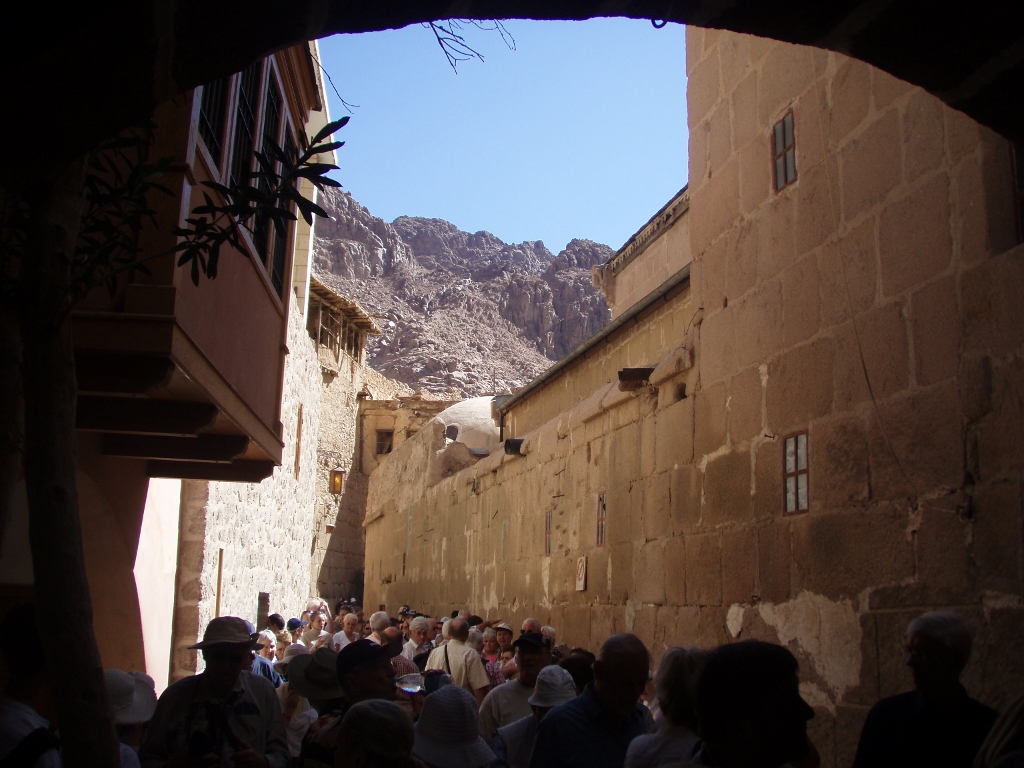 St. Catherine’s Monastery, a detail
St. Catherine’s Monastery, a detail
Then I went with the group to the church where it was not permitted to take photos.
I have already mentioned that this three-aisled church is dedicated to the Transfiguration of the Lord, although the entire monastery is named after St. Catherine of Alexandria. In fact, in a cave in this area, the body of this saint was found at some point and her relics were transferred to the monastery, which then became a significant pilgrimage destination, leading to a change in the monastery’s name.
As for the church, impressive details can still be seen today, some of which have survived since the original building from the 6th century. Everyone can enter, but only Orthodox Christians (Greeks, Russians, Serbs, etc.) are allowed to enter the fenced-off right aisle, where they can leave a note with the names of those they wish to be mentioned in the prayer on that day and they also have the opportunity to kiss the relics (hand) of St. Catherine. The monk who is there on duty then gives them a ring engraved with the name of the Monastery of St. Catherine.
We passed through the church and the exit was through the side door.
On the east side of the church, where its apse is located, there is the Chapel of St. Helena, dedicated to the Mother of God, which represents the oldest sanctuary within the monastery. One can enter the chapel but must remove their footwear, just as God commanded Moses.
The chapel is built above the roots of the Burning Bush from which the plant grows like a green shrub.
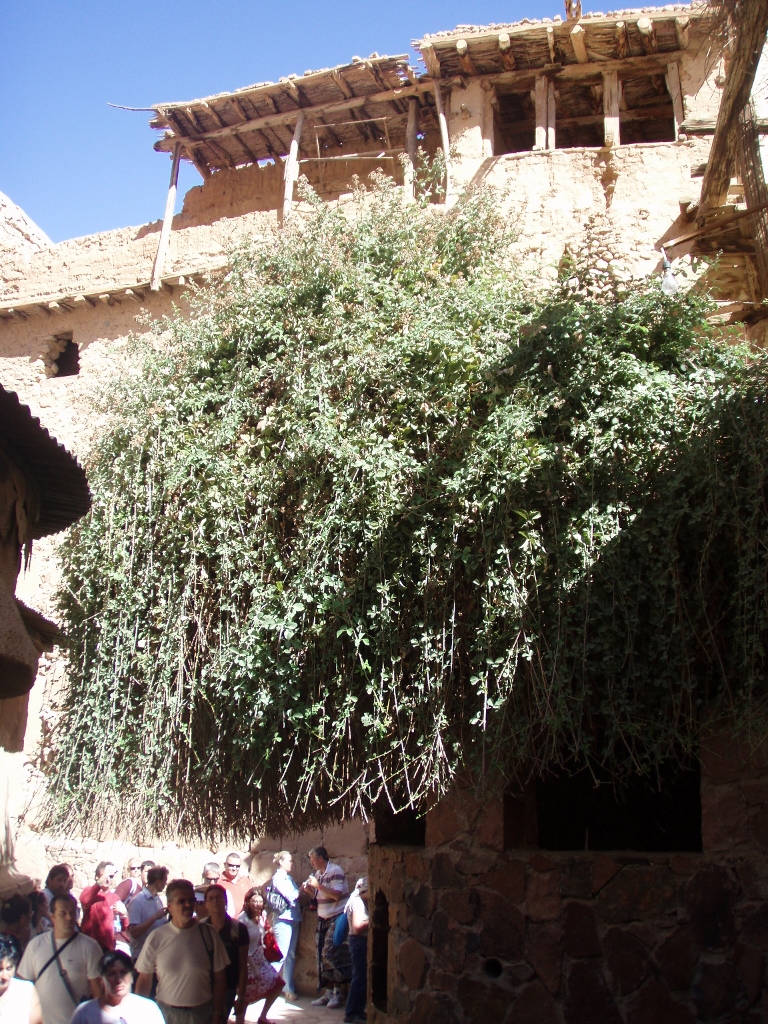 St. Catherine’s Monastery, a detail
St. Catherine’s Monastery, a detail
According to the tradition, it was from this bush that God first appeared to Moses. Besides its immeasurable spiritual significance, what is interesting about this centuries-old plant, within the scope of reality, is that it does not bear fruit and whenever attempts were made to transplant it, taking a cutting to another location, this apparently failed.
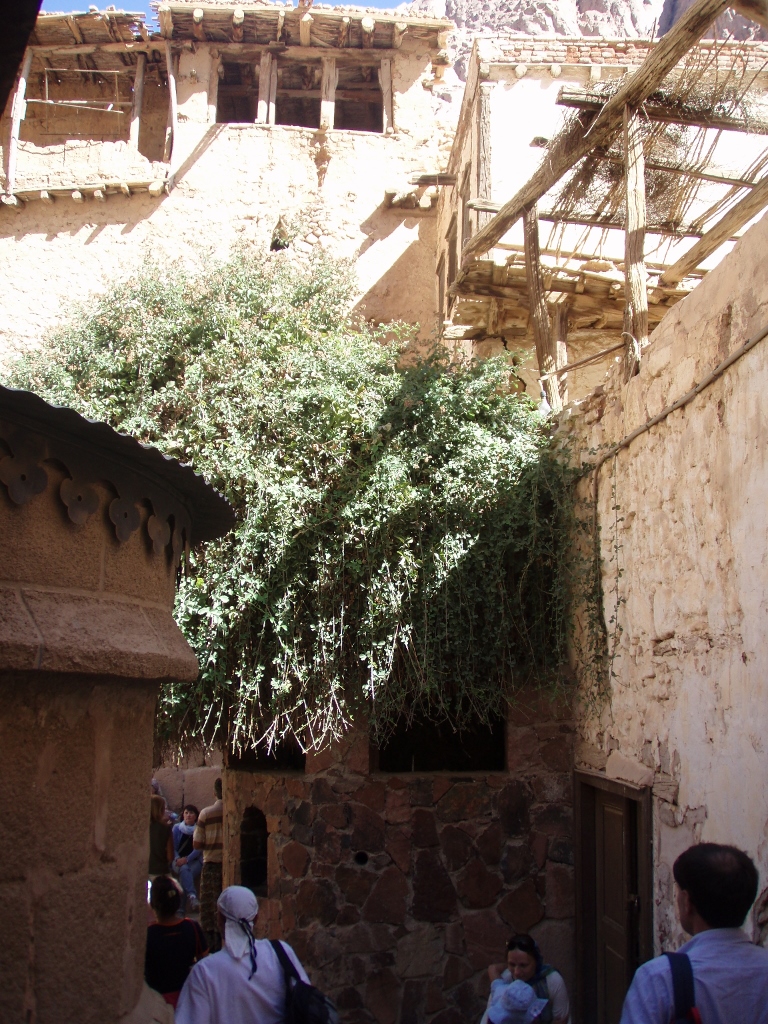 St. Catherine’s Monastery, a detail
St. Catherine’s Monastery, a detail
Within the monastery, there is also the oldest continuously operating library in the world and visitors can tour a museum as well. Namely, the monastery houses very significant works - both manuscripts and icons.
After this, I left the monastery with the group I went on this excursion with, so then we went to the parking lot and continued on our way.
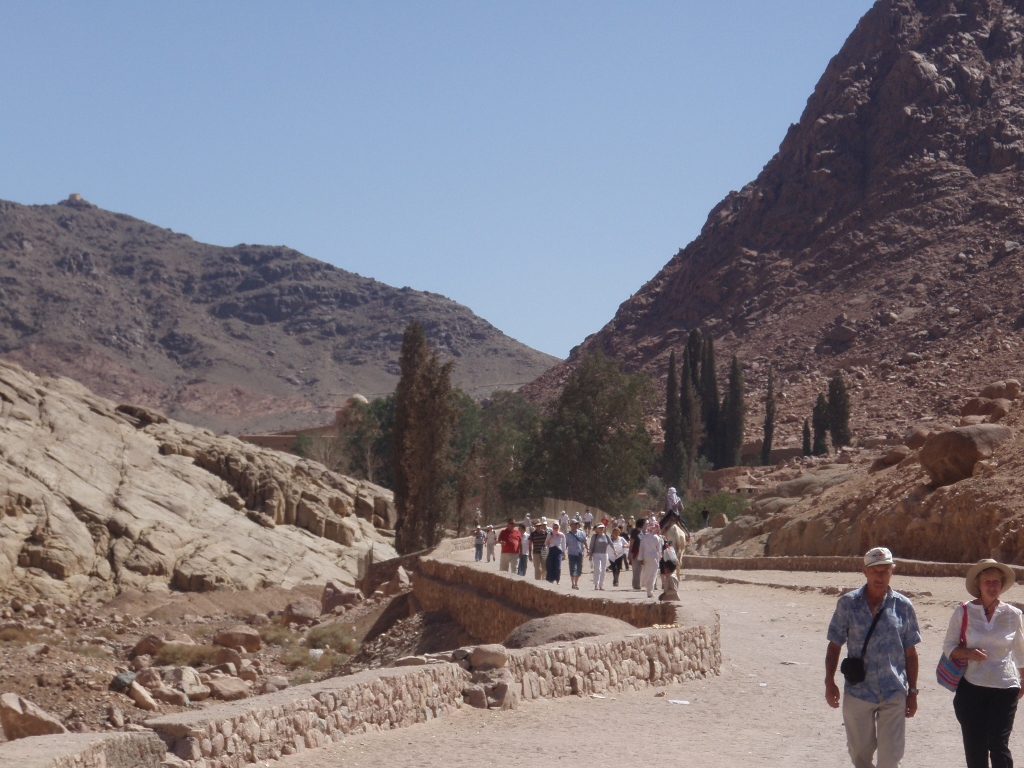 Leaving St. Catherine’s Monastery behind
Leaving St. Catherine’s Monastery behind
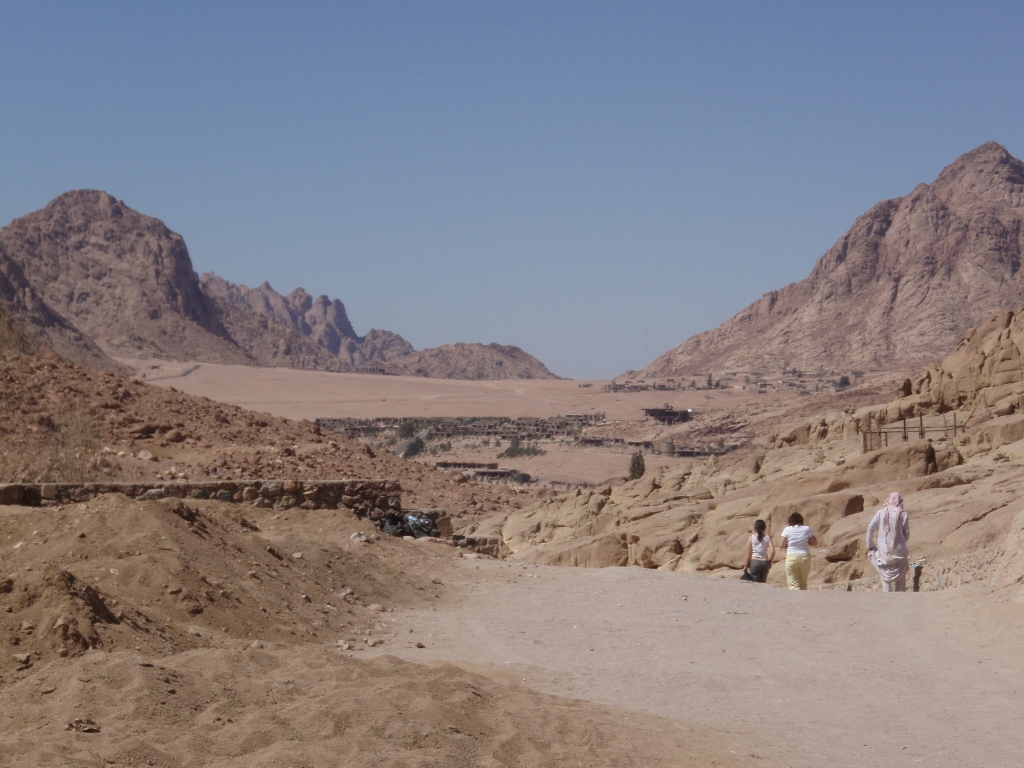 Path towards the parking lot
Path towards the parking lot
The next destination on this excursion was the town of Dahab on the eastern coast of the Sinai Peninsula.
Dahab was once a fishing village, but now tourism is the main activity. It is known as a great spot for diving, as well as windsurfing, kiteboarding, etc. Interestingly, just 26 km across the sea lies the coast of Saudi Arabia.
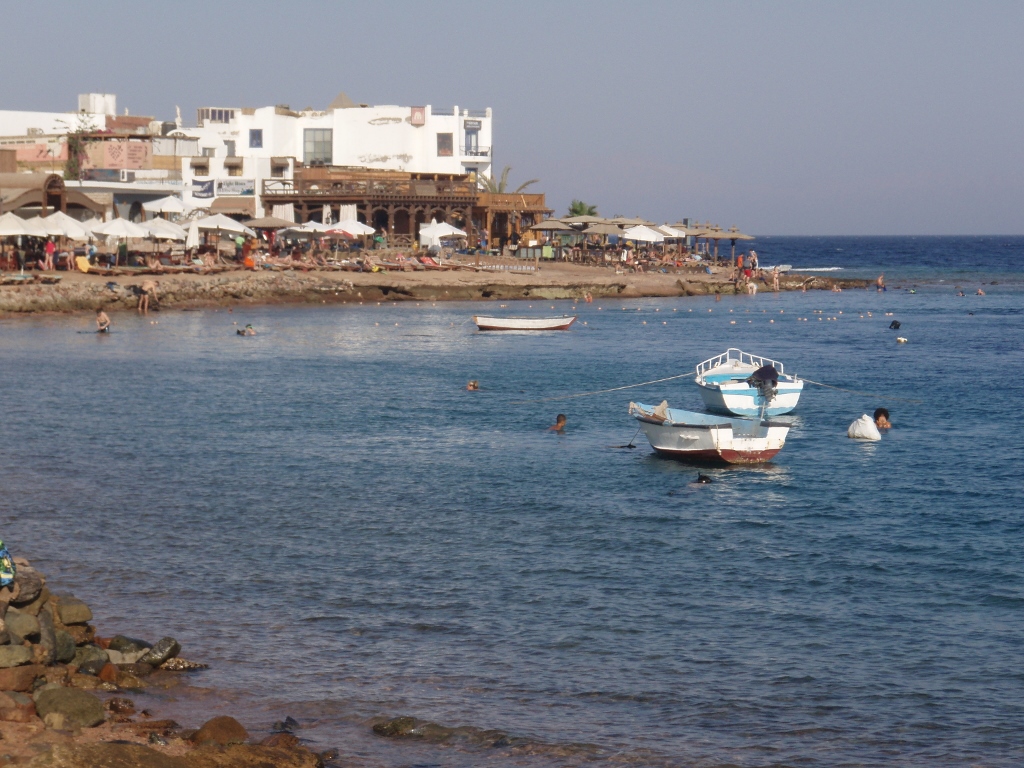 Dahab
Dahab
They drove us to a part along the coast and although there is a beach where one can swim if they wish, everything is still geared towards tourism – there is a promenade with numerous shops, as well as cafés and restaurants. However, we didn’t stay here for too long because it was important for everyone in the group to return to their hotels and get a good rest, considering the previous night and the lack of sleep.
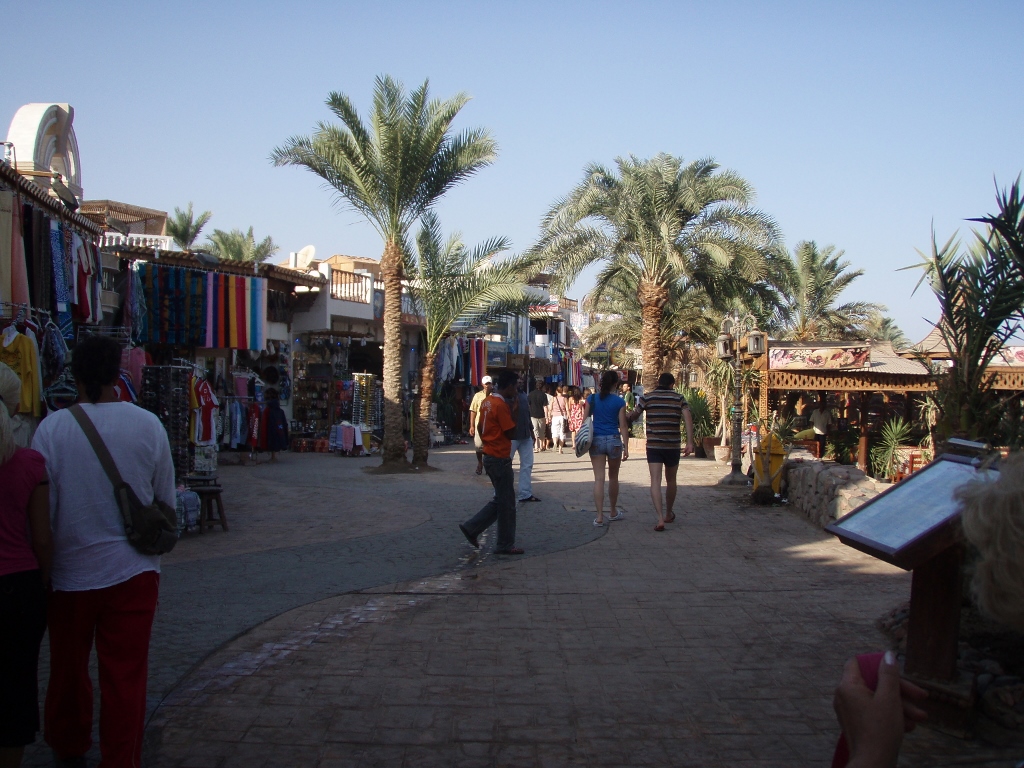 Dahab, a detail
Dahab, a detail
During this stay in Sharm El-Sheikh, I went on another excursion, but this time I took my mom with me.
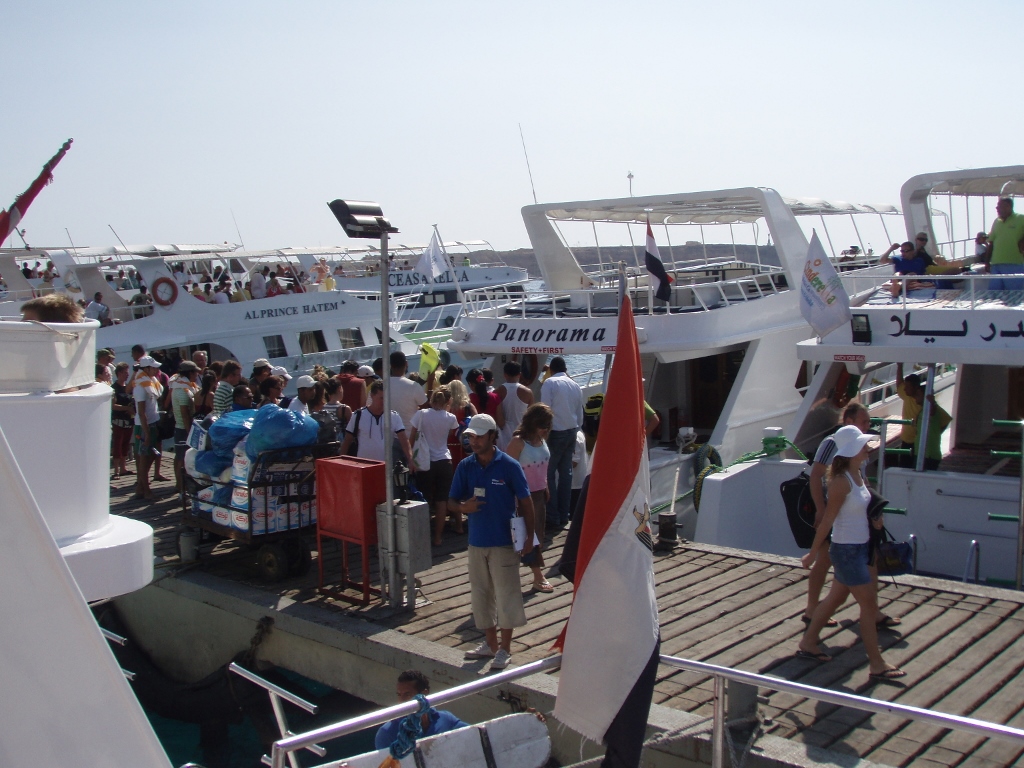 Excursion boats
Excursion boats
The excursion was by boat and included a visit to the waters around Tiran Island, but we didn’t disembark on the island itself. Firstly, because there was no need as we were going snorkelling and, secondly, because there had been decades-long negotiations between Egypt and Saudi Arabia regarding the ownership of Tiran (along with Sanafir Island). Since 2017, Tiran and Sanafir have officially become the sovereign territory of Saudi Arabia.
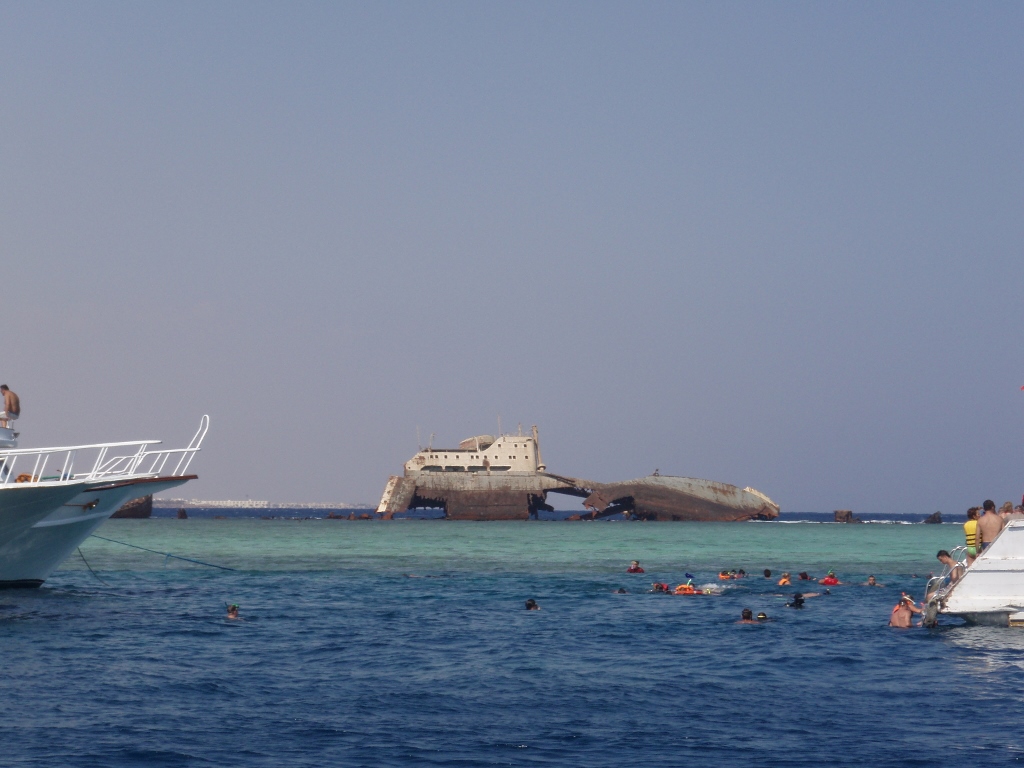 Snorkelling spot
Snorkelling spot
The Red Sea is famous as an exceptional place for snorkelling and diving, but although I feel very comfortable in the water, for some reason unknown to me, I have never been particularly drawn to diving. However, that didn’t stop me from capturing a group of divers who also came here on an excursion.
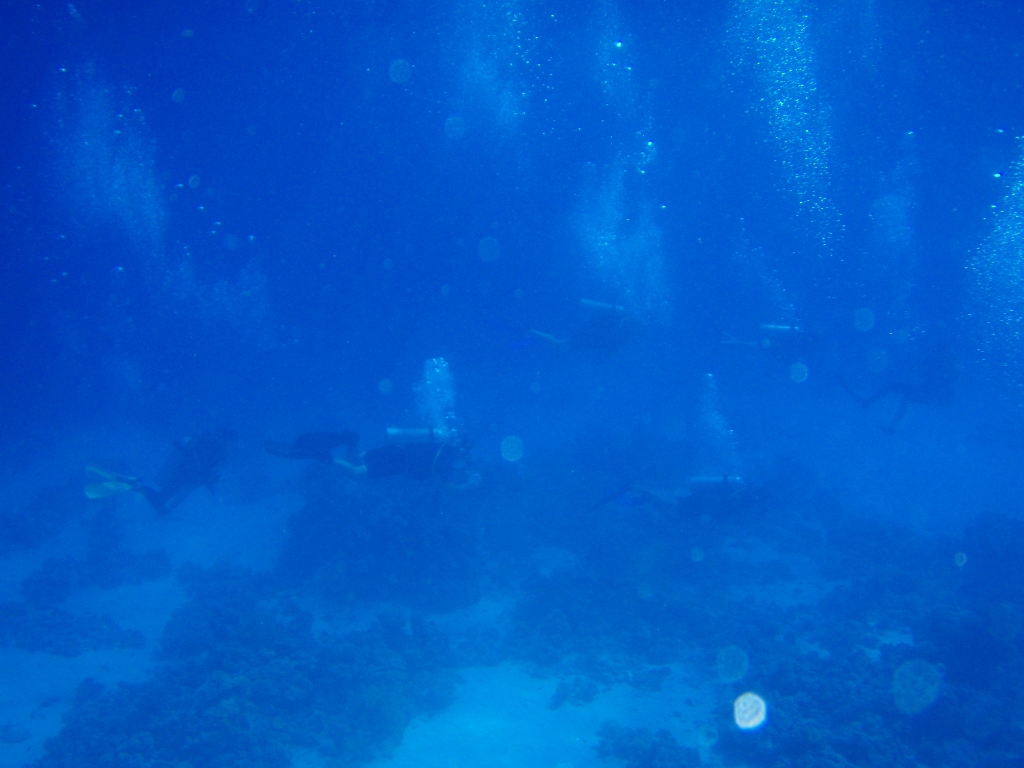 Divers on an excursion in the Red Sea
Divers on an excursion in the Red Sea
As for me, I was very happy just snorkelling. Although I regularly saw some types of fish near the hotel, I was not in the least bit tired of seeing and capturing them here as well.
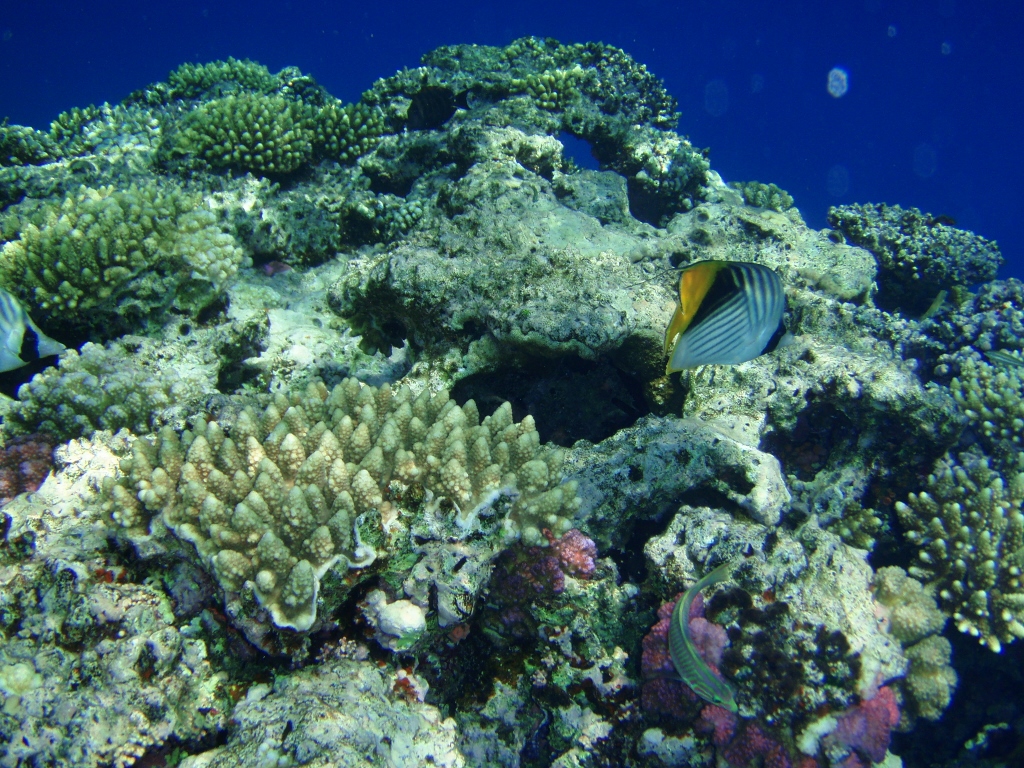 Red Sea marine life
Red Sea marine life
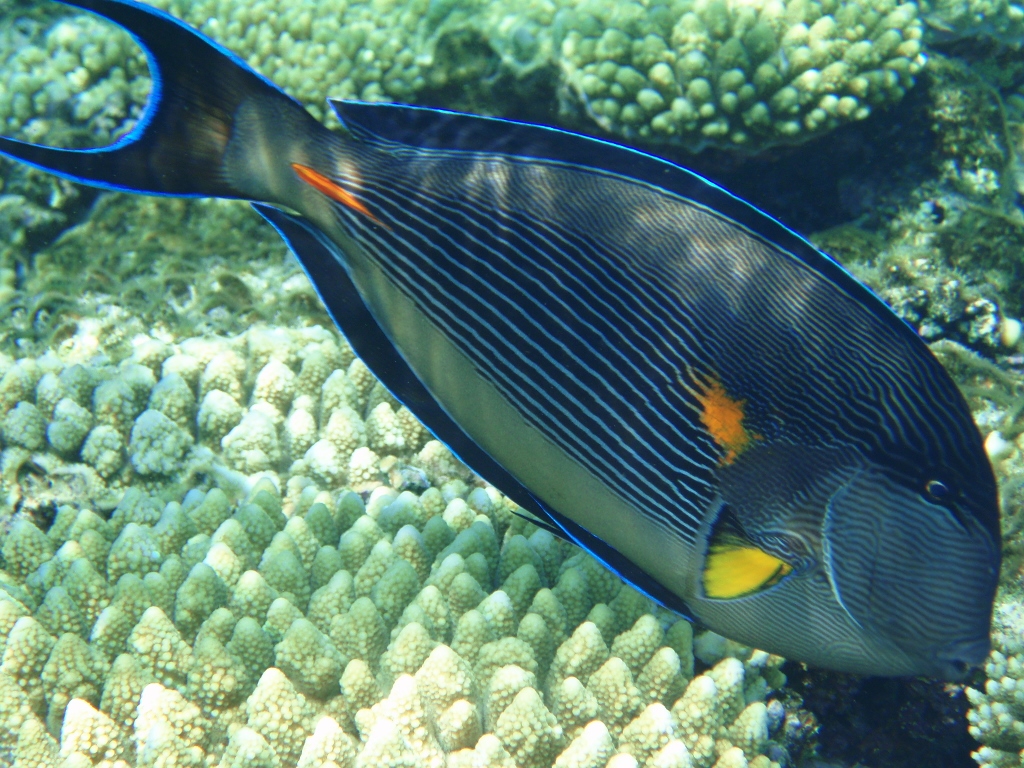 Red Sea marine life
Red Sea marine life
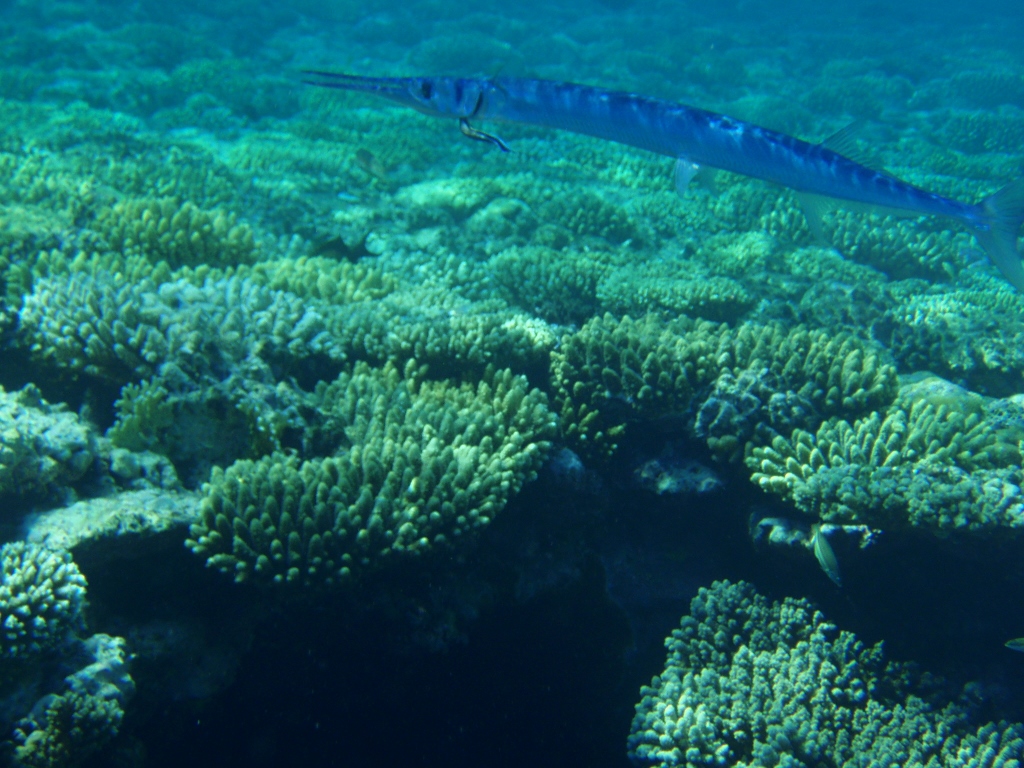 Red Sea marine life
Red Sea marine life
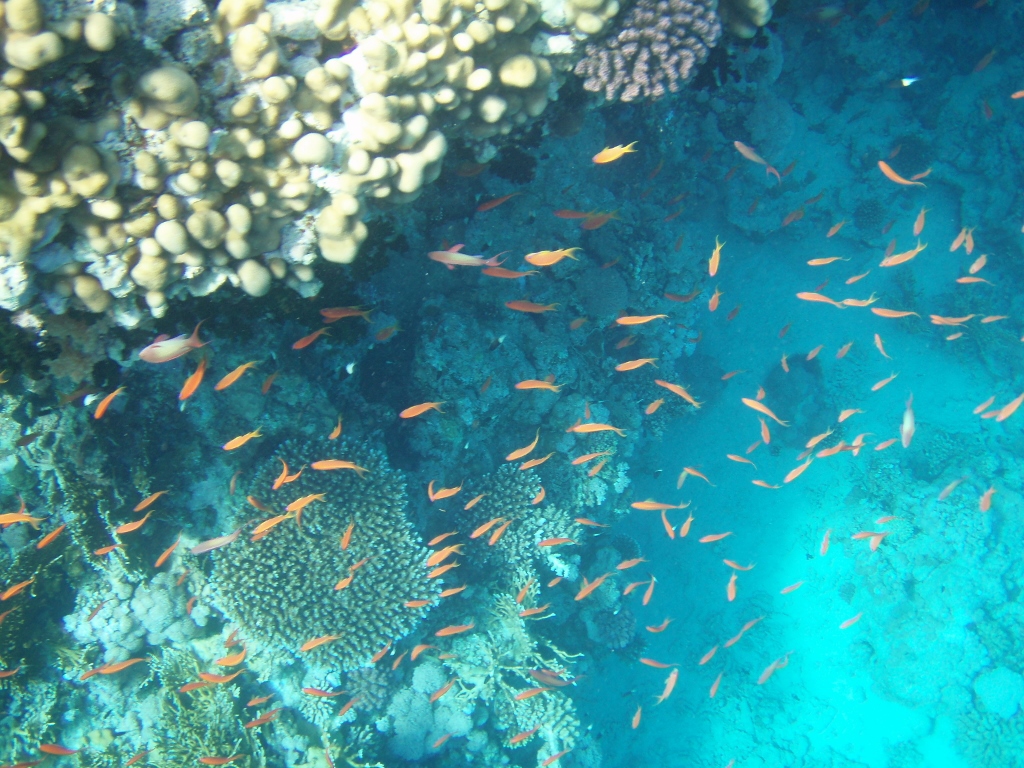 Red Sea marine life
Red Sea marine life
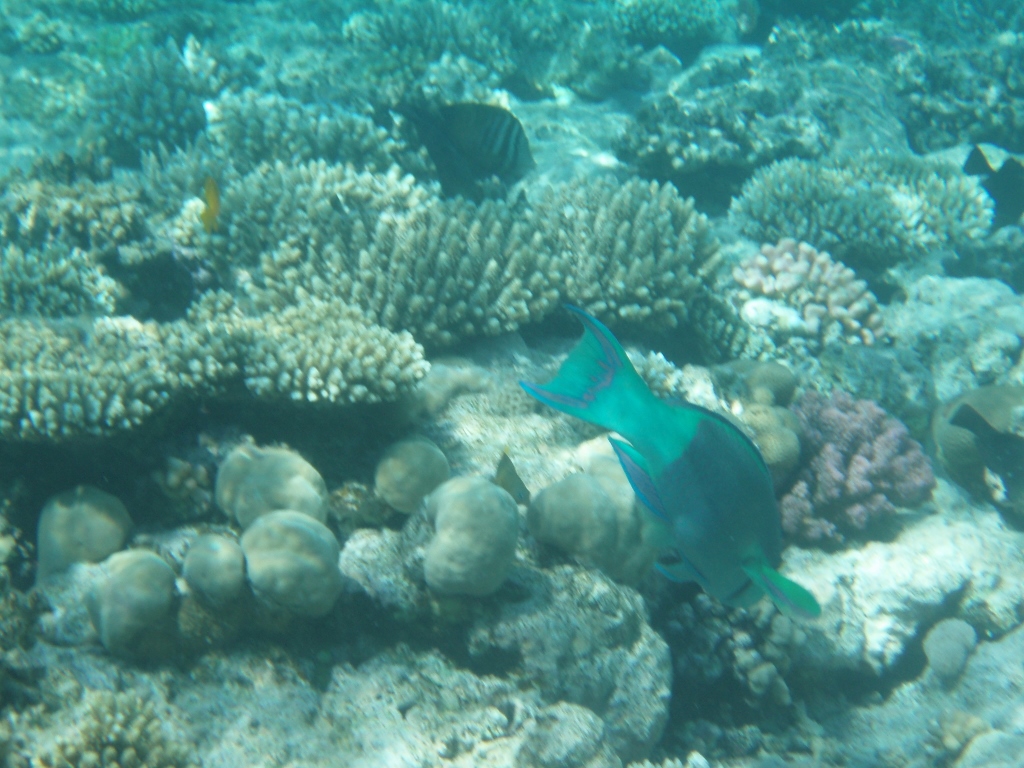 Red Sea marine life
Red Sea marine life
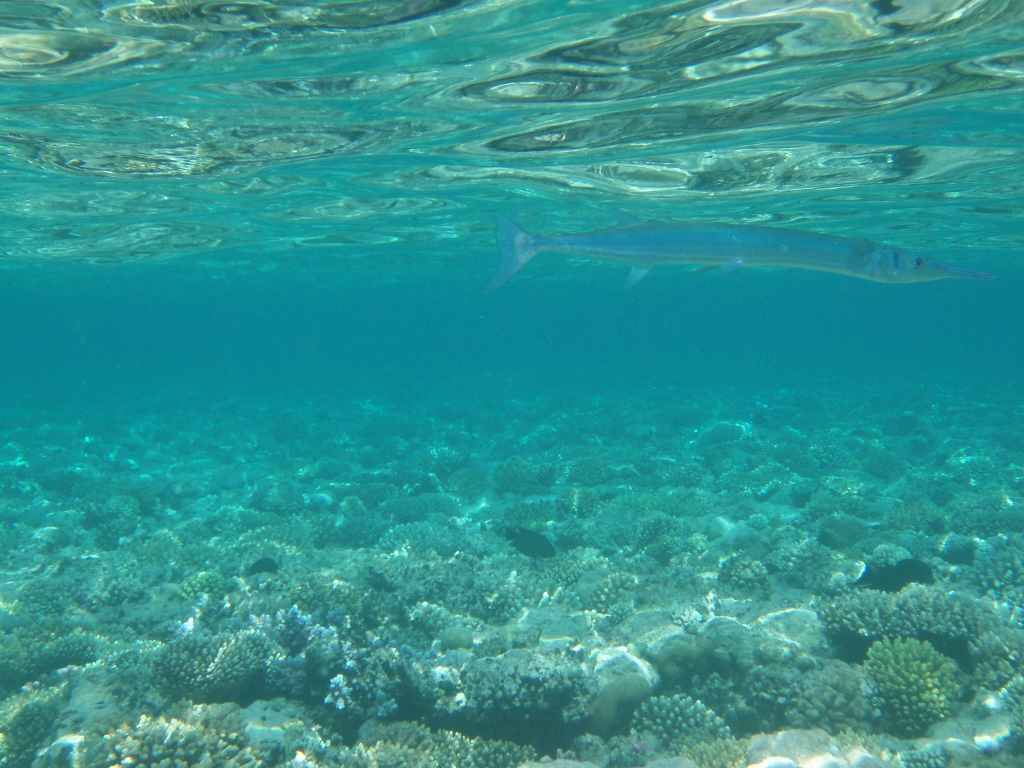 Red Sea marine life
Red Sea marine life
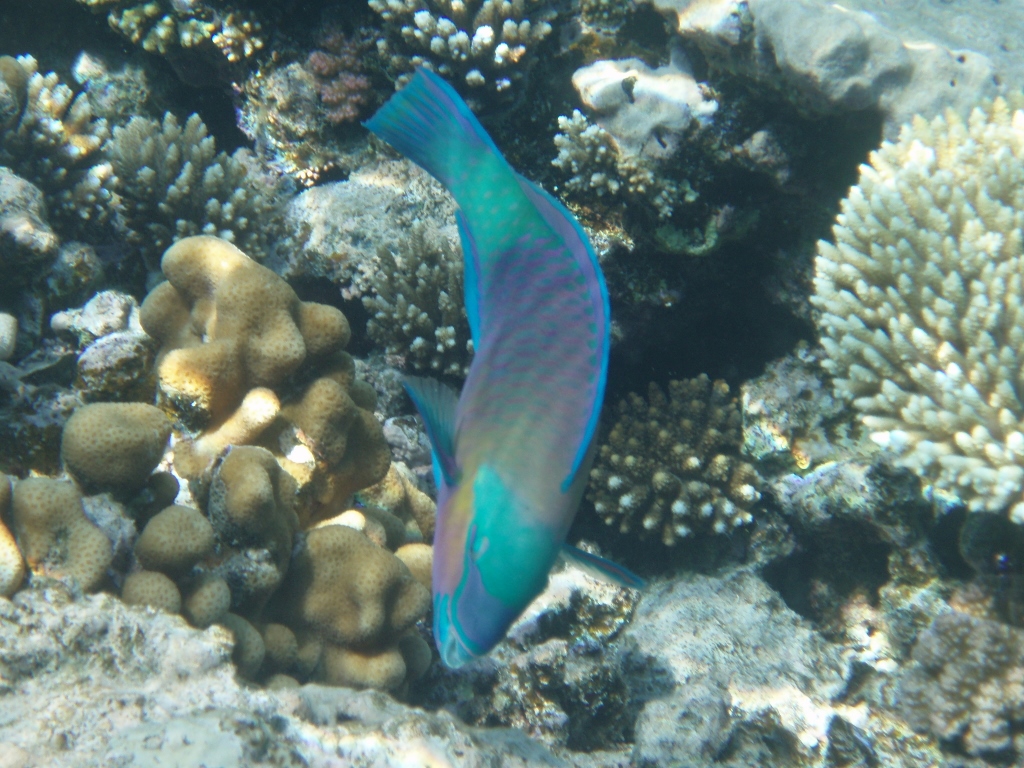 Red Sea marine life
Red Sea marine life
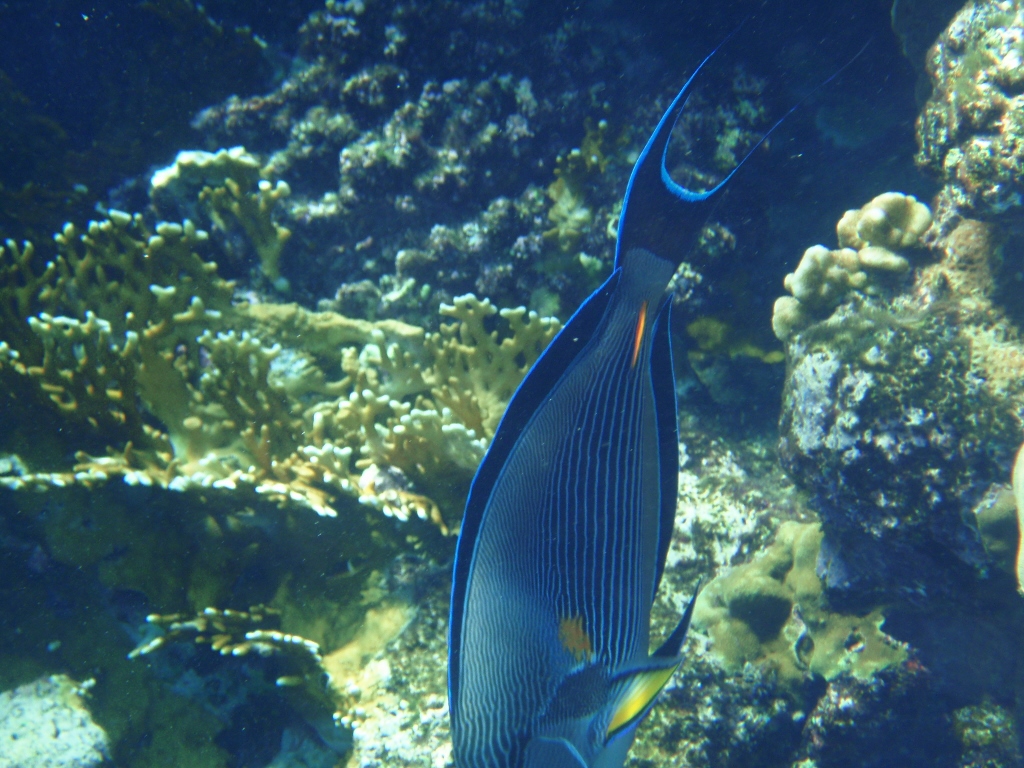 Red Sea marine life
Red Sea marine life
The excursion also included swimming in deeper waters and when we anchored, I convinced my mom to join me in the water. She had always been a good swimmer, but age had taken its toll and she was 75 at the time. When a slightly stronger current started to carry us, she got scared. I was quite delighted as I enjoyed swimming with her almost in the open sea, but she became increasingly panicked. People on the boat noticed this, so they threw her a lifebuoy attached to a rope from the boat, pulling her towards safety and she was able to get out without problems. I continued swimming for a bit longer before returning to the boat myself. My mom grumbled good-naturedly about allowing herself, an “old woman,” to be persuaded by me to crazily enter the water at that spot. Everything turned out well in the end and I know that the entire trip was unforgettable for her.
We spent the rest of the time in Sharm El-Sheikh at the resort, mostly by the pool, although I still regularly went to the jetty and enjoyed watching the colourful fish of the Red Sea there.
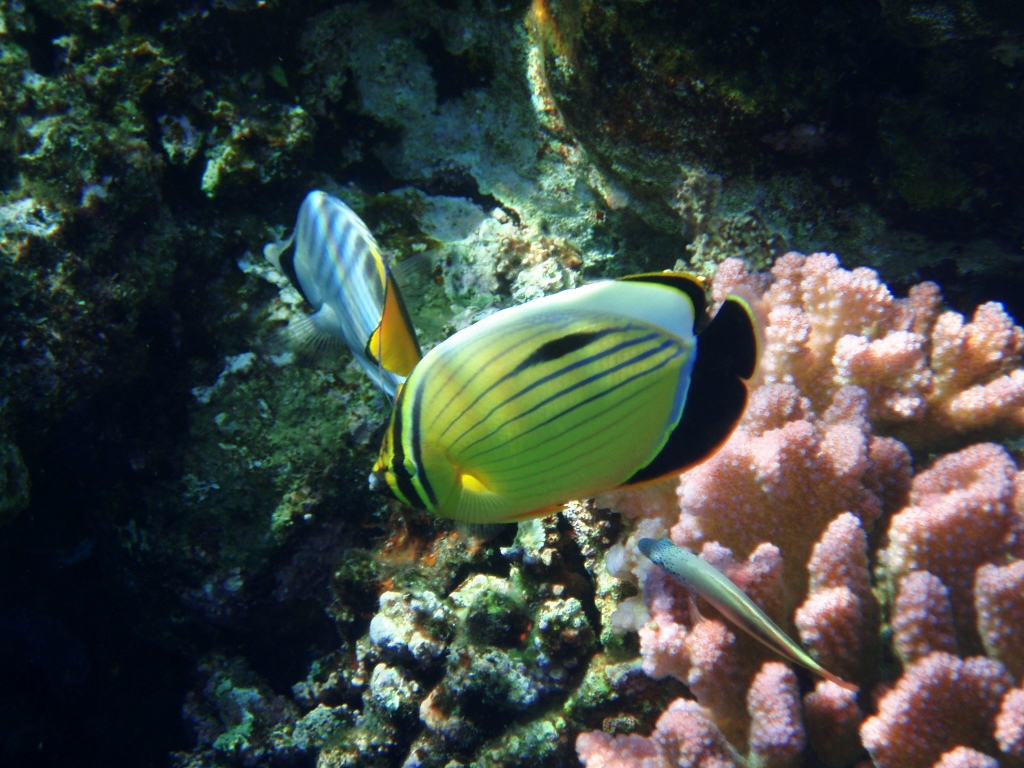 Red Sea marine life
Red Sea marine life
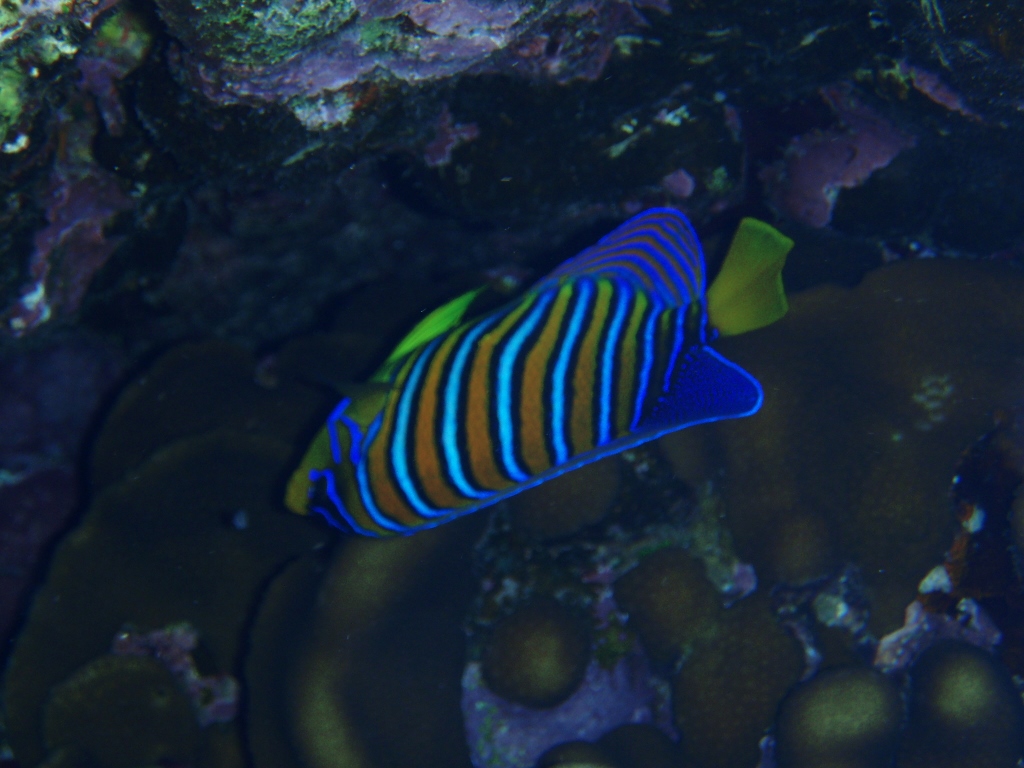 Red Sea marine life
Red Sea marine life
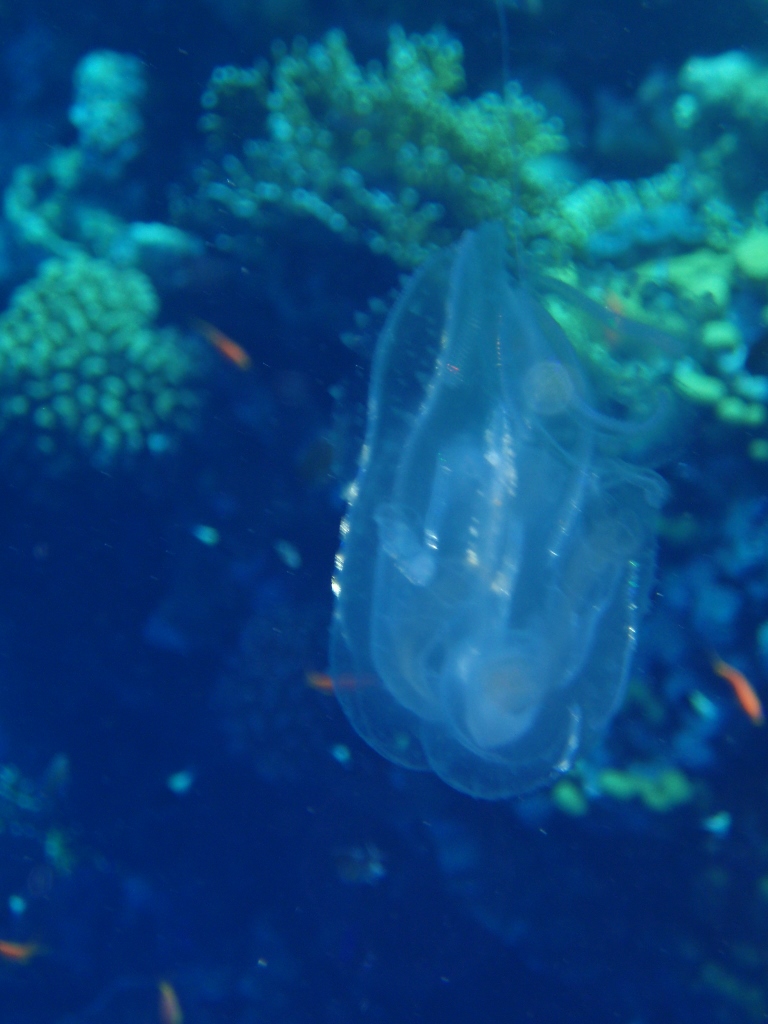 Red Sea marine life
Red Sea marine life
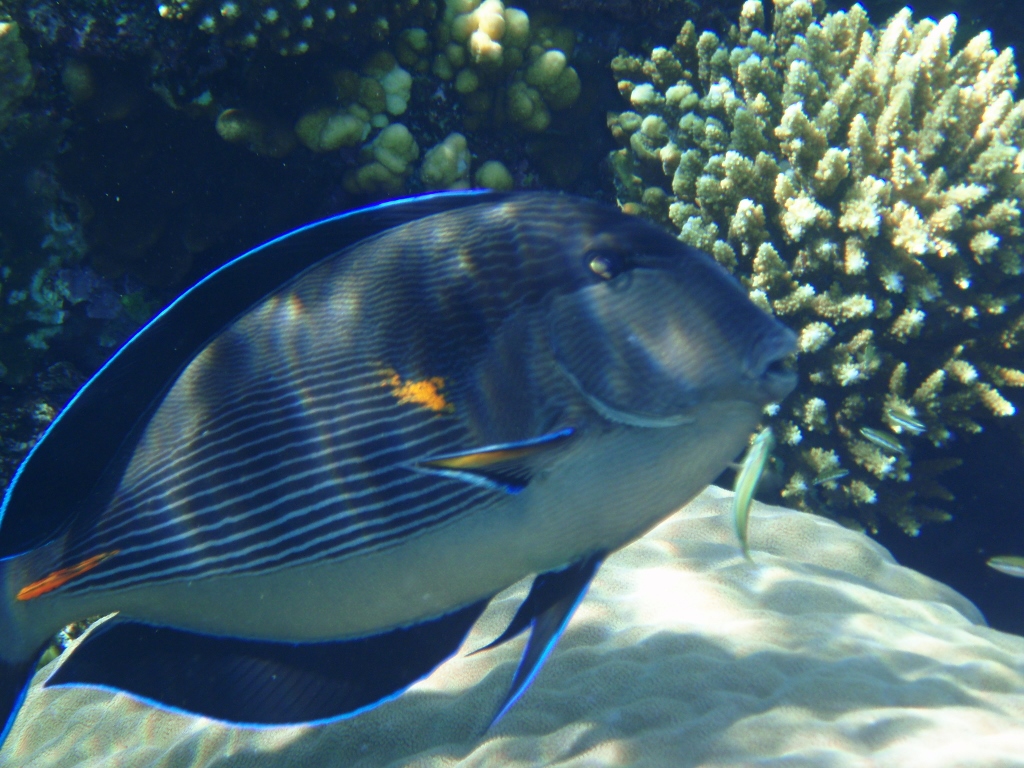 Red Sea marine life
Red Sea marine life
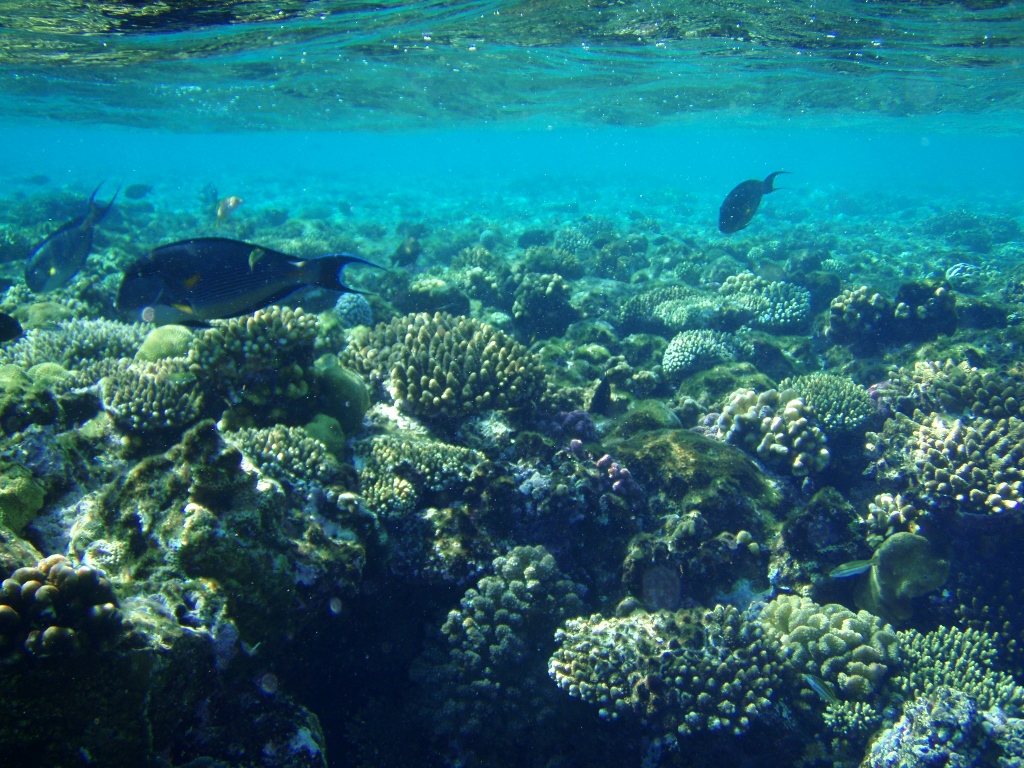 Red Sea marine life
Red Sea marine life
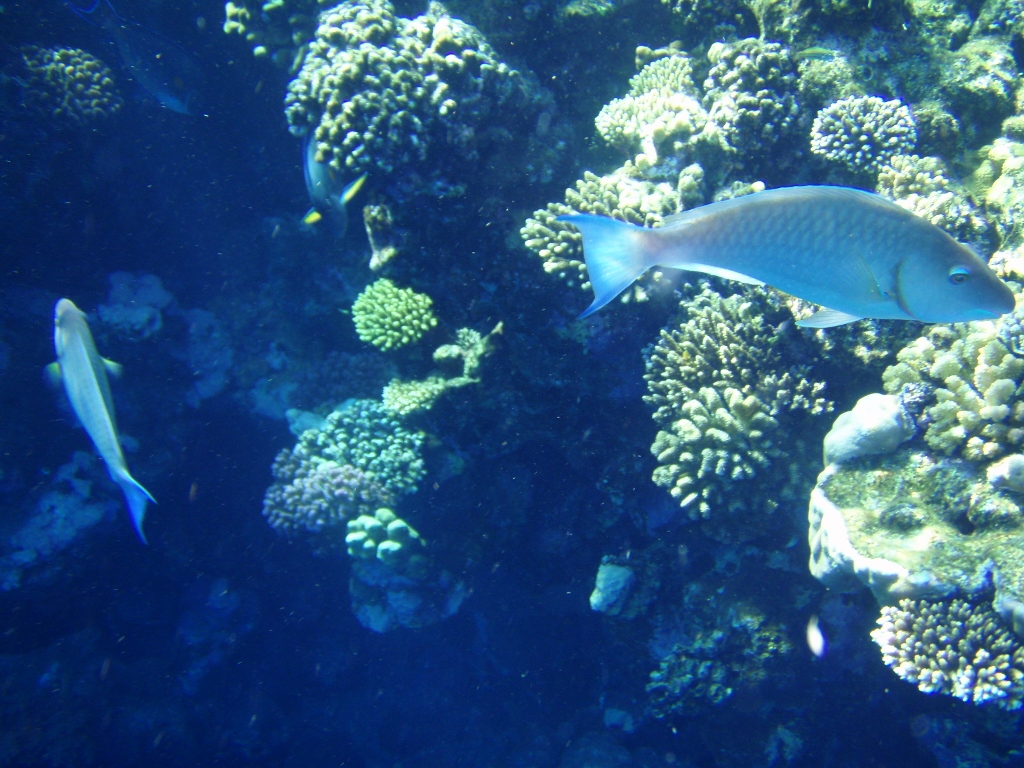 Red Sea marine life
Red Sea marine life